北外_02-07_语言学及应用语言学真题
北京外国语大学 02-07 语言学及应用语言学真题

2002年语言学与应用语言学(100 points)All the questions are to be answered in English on the answer sheets provided.1. Displacement,arbitrariness,productivity,cultural transmission,discreteness and duality are sometimes listed as the 6 core features of human language.Choose 3 out of the 6 and explain with examples what they mean. (12 points)2. Briefly explain what phonetics and phonology are concerned with and what kind of relationsips hold between the two.(10 points)3.In deriving new words via a prefix such as mis-, there seems to be some constraint on what is permitted. The words in the first colum below are acceptable formations,but in the other columns are not.Work out what the rule(s) might be for making new adjectives with the prefix mis-. (18 points)Column I : misadventure misjudgement misplaced mistrustfulColumn II: *mishappy *mismeal *misglad *misroleColumn III: *mismilk *missad *misword *miscrazy4. Using what you know about Grice's cooperative principle and its four maxims,analyze the following short exchange.(20 points)同事甲:小张昨晚去哪儿了?同事乙:今天在早上我看见一辆白色富康停在小林家门口。
北外考研网上资源-百度文库链接

北京外国语大学考研网上资源2013年北京外国语大学英语翻译硕士(MTI)考研经验/view/1a221e10e87101f69e31957a.html北京外国语大学考研基础日语-常考动词100词/view/4ea188d0aa00b52acfc7ca80.html北京外国语大学俄语语言文学考研经验(辅导成果展)/view/ca663c48804d2b160b4ec063.html北京外国语大学考研基础日语人体谚语总结/view/3e8591e17c1cfad6195fa781.html北京外国语大学日语系日研中心基础日语复习资料外来语词汇整理(五) /view/bbd1bf1290c69ec3d5bb7586.html北京外国语大学日语系日研中心基础日语复习资料-外来语词汇整理(四) /view/b94fe5a8f121dd36a32d8287.html北京外国语大学日语系日研中心基础日语复习资料——外来语词汇整理(三) /view/329fdf08b7360b4c2e3f6484.html北京外国语大学日语系日研中心复习资料-外来语词汇整理(二)/view/d506915de45c3b3567ec8b85.html北京外国语大学日语系日研中心复习资料-外来语词汇整理(一)/view/b134122267ec102de2bd897a.html北京外国语大学日本语研究中心复习资料-中日关系史总结/view/67e2c52d87c24028915fc37b.html考研二外日语(203)复习经验/view/47338415de80d4d8d15a4f7f.html北京外国语大学英语翻硕(MTI)复习资料翻译笔记——倍数/view/26d98e3358fb770bf78a55ab.html北京外国语大学考研二外英语复习资料语法/view/3b89f1c1195f312b3169a5a9.html北外考研英语语法分词/view/541688c749649b6648d747af.html2014年北外高翻笔记保险种种/view/4f5f2de8f705cc17552709a0.html北外考研241英语语法数词/view/252cbb667fd5360cba1adba1.html北京外国语大学考研辅导资料词组翻译/view/c69e59c480eb6294dd886ca6.html北外考研241英语复习资料精华词汇、词组翻译/view/3d09ee2d580216fc700afda5.html北外考研241英语复习资料同系宾语/view/3a935e300722192e4536f699.html北外考研二外英语考研统考英语201英语复习资料精句解析/view/a31160fb0975f46527d3e19e.html北外高翻英汉同传翻译笔记not 的巧用/view/ab4d3a056edb6f1aff001f93.html 2014年北京外国语大学高翻考研英汉同传翻译笔记/view/921715ae1a37f111f1855b97.html翻硕学员北外英语翻译硕士MTI考研经验/view/d86b8e6b27284b73f242505c.html 2014北京外国语大学日本学研究中心考研经验总结/view/ca30026701f69e314332944b.html北京外国语大学北外考研二外日语公共日语大纲句型/view/4d3ced34192e45361066f537.html北京外国语大学日本学研究中心考研经验总结/view/0c3a531b6c85ec3a87c2c527.html北京外国语大学考研翻译硕士(MTI)资料百科名词解释汇编/view/0d07e1b7284ac850ad0242d2.html2014北京外国语大学英语翻译硕士(MTI)英文缩略语集锦/view/1663cd1a844769eae009edc2.html 2014年北京外国语大学英语翻译硕士考研复试资料常用口语/view/c34f87cca58da0116c174973.html北外241考研英语复习资料北外二外英语复习与日、夜相关的惯用语/view/d282fc12cc17552707220891.html2014年北京外国语大学高翻同传备考指导之庄绎传漫谈翻译(四) /view/a7e40b3ebd64783e09122b58.html北京外国语大学243二外法语考研资料语法时态总结/view/2ce80d4a3b3567ec102d8abc.html北外日语系考研核心词汇(上)/view/f2005a1976c66137ef06190c.html2014北京外国语大学英语学院国别研究英美概况的笔记/view/db1ebc0e10a6f524cdbf850e.html2014年北京外国语大学高翻同传备考指导之庄绎传漫谈翻译(一) /view/0a5a5d0552d380eb62946d42.html2014年北京外国语大学高翻同传备考指导之庄绎传漫谈翻译(三) /view/e8157c342f60ddccda38a05e.html北京外国语大学考研要求达到六个境界/view/8b421854336c1eb91a375d4d.html北外日语系考研核心词汇(上)/view/4d23ed34192e45361066f51e.html2014年北京外国语大学高翻同传备考指导之庄绎传漫谈翻译(五) /view/7ba0eb1e581b6bd97f19ea64.html2014年北京外国语大学高翻同传备考指导之庄绎传漫谈翻译(二) /view/47b89f09a76e58fafab00352.html2014 北外高翻经济学人常用词汇/view/e71077c684254b35eefd3430.html北京外国语大学北外二外日语公共日语大纲句型(一)/view/ae1c8dfa102de2bd96058845.html2014年北外二战容易遇到的问题及建议/view/c2bfa6fa856a561252d36fae.html北京外国语大学2013年接收推荐免试硕士研究生办法(北外研究生处保研文件) /view/f576ff5cfe4733687e21aa79.html北京外国语大学考研二战经验指导/view/d0fccd3c0066f5335a812132.html2013年北外对外汉语专业复试真题复试流程复试经验/view/550af07aa417866fb84a8e32.html2013年北京外国语大学语言学及应用语言学对外汉语真题(语言综合卷) /view/e85d3d2c482fb4daa58d4b13.html2014年北京外国语大学对外汉语考研经验/view/9fe82f4ab307e87101f696dc.html2014年北京外国语大学英语翻译硕士笔译考研经验(北鼎学员提供)/view/051979dd76a20029bd642da2.html2014年北外高翻T型口译笔记法/view/181844abf121dd36a32d8254.html2014年北京外国语大学复试常见问题汇总/view/d49f90312f60ddccda38a0e4.html考研政治复习攻略、政治复习方法/view/4b9a33383169a4517723a3dd.html2013年北京外国语大学语言学及应用语言学对外汉语专业真题(现代汉语卷) /view/ce39b1dbb14e852458fb57ff.html北京外国语大学2013考研真题-翻译理论与实践-英汉互译(同传)真题/view/1db5150890c69ec3d5bb7513.html北京外国语大学2013年翻译硕士笔译考研参考书、考试经验、复习方法及复试经验/view/7be71d89ec3a87c24028c4f2.html北京外国语大学国际汉教2013年参考书目、考试内容及备考经验分享/view/10bdd66258fafab069dc02aa.html2013年北京外国语大学法语语言文学考研经验、参考书目/view/d1115175168884868762d610.html2014年北外德语语言文学德语外交与经济考研经验、参考书、考研真题/view/b0462a3d43323968011c92b8.html诺顿美国文学选集-总目录5/view/0cecc610227916888486d73a.html北外英美文学专业初试复试备考经验及03/view/ac551d5877232f60ddcca143.html2014年北京外国语大学英语翻译硕士考研经验复试经验参考书真题解析/view/c404192f482fb4daa58d4b6f.html2014北外日研中心考研经验、考试攻略及参考书目/view/c4b5cafff90f76c661371a69.html2013年法语学硕考研经验/view/fae0e92daf45b307e8719790.html诺顿美国文学选集-总目录 6/view/8edd01ff7c1cfad6195fa73a.html北京外国语大学英美文学答案2005/view/945ec728af45b307e8719745.html北外研究生复试与录取/view/42a79a7801f69e31433294af.html北外考研报考条件/view/a15f2afcf61fb7360b4c65a4.html新闻热词流浪儿童/view/471c2de1856a561252d36f46.html北外高翻09年考研经验集合/view/be2298aef524ccbff1218446.html北京外国语大学2010高翻考研经验√/view/413a2ecb0c22590102029d46.html北京外国语大学日本学研究中心考研参考阅读(1)/view/8707f49cdd88d0d233d46af1.html诺顿美国文学选集-总目录1/view/4f15643fa32d7375a417803b.html2012翻译硕士MTI考研经验/view/8e01c31010a6f524ccbf85f1.html诺顿美国文学选集-总目录3/view/b3e378ce08a1284ac850433b.html冲刺阶段阅读理解总结/view/181e44b7f121dd36a32d8246.html新闻热词版税收入/view/e0231e43cf84b9d528ea7a46.html新闻热词“新主流消费群”兴起/view/29c406f704a1b0717fd5dd37.html诺顿美国文学选集Vol.1/view/a82a1e6758fafab069dc0238.html北京外国语大学2014研究生招生简章-参考版/view/cee34eb6c77da26925c5b028.html新闻热词“新主流消费群”兴起/view/53d9da45e518964bcf847c46.html新闻热词全体会议/view/74af5580d0d233d4b14e6946.html新闻热词飓风“桑迪”/view/0577a6375727a5e9856a6146.html考研考场应试成功15个细节,很有帮助/view/8cadf5dc28ea81c758f57837.html诺顿美国文学选集-总目录 2/view/4bc203044a7302768e99393b.html高翻考研经验集合/view/572d0e67b84ae45c3b358c46.html诺顿美国文学选集-总目录4/view/a82b1e6758fafab069dc023b.html新闻热词工业大迁移/view/8bfcd0fdf61fb7360b4c6546.html新闻热词高原反应/view/b1eea0e281c758f5f61f6746.htmlMTI缩略语/view/344b89fe9e31433239689346.html2013英语专业考研翻译题(二)/view/d565b9233169a4517723a346.html2013考研冲刺健康复习作息时间表/view/7bd191e0b8f67c1cfad6b846.html北外研究生课程培养方案/view/f56fd608a6c30c2259019e79.html外校报送北外研究生办法(内附北外研招办联系方式)/view/8102cd42e45c3b3567ec8b70.html关于提前做好2013国家建设高水平大学公派研究生项目申请准备工作的通知/view/f34ca83ea32d7375a4178070.html448百科知识和汉语写作模拟题/view/992c8346767f5acfa1c7cd46.html翻译硕士英语样题/view/c8a431dd28ea81c758f5782d.html2012MTI翻译硕士考研口译初试370复试163/view/17fd2208b52acfc789ebc946.html关于2012年研究生申请参加国内学术会议资助的通知/view/4572100652ea551810a68770.html翻译资格证考试介绍/view/251e8bd0ce2f0066f5332221.html北外研究生录取-博士/view/5d6b9d7901f69e3143329470.html17句搞定考研英语作文/view/b8439e8084868762caaed546.html北外博士研究生培养方案/view/fbb6fede3186bceb19e8bb79.html翻译硕士MTI考研真题全集2011年/view/1d233d22cfc789eb172dc829.html关于2012年秋季学期研究生期末教学安排的通知/view/ca047414a300a6c30c229f70.html北外博士研究生招生简章/view/4236c60fe87101f69e319579.html新闻热词停火/view/b5e9ac04844769eae009ed46.html关于2013年硕士研究生全国统考资格审查的通知/view/ab7465aef524ccbff1218470.html北外研究生出国机会/view/15238b4f33687e21af45a970.html北外考研录取通知书/view/feb6d085a0116c175f0e4871.html北外复试考场安排/view/1fb8c446852458fb770b5671.html北外本校报送北外研究生-办法/view/75bff5e36294dd88d0d26b71.html报送研究生申请流程/view/8185f062561252d380eb6e71.html北京外国语大学本科生论文格式/view/fb9446dcb14e852458fb574b.html英语专业考研英美文学考研经验/view/8d8cd959f01dc281e53af05b.html北京外国语大学应用语言学考研经验/view/990eca2b482fb4daa58d4b59.html北京外国语大学英语翻译理论与实践复试经验/view/7a87f4e36294dd88d0d26b59.html北京外国语大学外交学复试经验/view/8c1fbb8cb9d528ea81c77959.html北京外国语大学日语语言学复试经验/view/294ab1d250e2524de5187e59.html北京外国语大学日语教育方向考研复试经验参考/view/8092eacbd5bbfd0a79567359.html北京外国语大学日研中心文化方向考研经验参考/view/ceeb8529dd36a32d73758159.html北京外国语大学美国社会文化研究复试经验/view/9372db4db307e87101f69659.html北外考研报名现场确认/view/cae9f6d849649b6648d74771.html北外考研成绩查询/view/49cd5d42c850ad02de804171.html北外考研报名-博士/view/c42e46641eb91a37f1115c71.html北京外国语大学英语学院考研指南/view/a4323cdfc1c708a1284a4459.html北京外国语大学国际传播复试经验/view/d87e996b0b1c59eef8c7b459.html北外考研调剂政策/view/d4493e3deefdc8d376ee3271.html翻译硕士考研经验经典转载/view/253b2cf2fab069dc50220158.html北外考研调剂校内/view/ec7d191f5f0e7cd184253671.html北外考研成绩复查/view/e96eab88d4d8d15abe234e71.html 北京外国语大学日本文化复试经验分享/view/5553d2cb0c22590102029d59.html北京外国语大学国际传播复试经验/view/6b94de08b52acfc789ebc959.html北京外国语大学法语笔译经验谈/view/ea59cf60a98271fe910ef959.html北外校历2012.4/view/fff1d185a0116c175f0e4836.html专业硕士与学术硕士的区别/view/6b162a39b90d6c85ec3ac615.html什么样的水平的学生可以成功考北外的研究生/view/8f292b3e10661ed9ad51f315.html如何推荐免试读研究生保研/view/e2db3e2aaaea998fcc220e0a.html考研分数线国家线2008-2011/view/2ad6ea2d4b35eefdc8d3330a.html开设翻译硕士的学校及参考书目/view/a547c69d6bec0975f465e20b.html汉语写作与百科知识复习指导/view/2f6b36f2fab069dc50220108.html翻译硕士MTI参考书目/view/8d25c14db307e87101f69608.html翻译硕士中有关百科问题解疑汇总/view/182adad2a58da0116c174908.html口译笔译同传交传翻译资格证翻译硕士/view/8107d0ddb9f3f90f76c61b0a.html考北京外国语大学研究生的问题解答-转载自北外研究生处/view/967c788084868762caaed50b.html招收翻译硕士的院校名单/view/5f6249db240c844769eaee15.html北京外国语大学法语口译考研经验谈/view/0ac61fe40975f46527d3e159.html北外2013研究生招生简章/view/acae983287c24028915fc331.html北外考研qq群/view/d3f124ea524de518964b7d36.html考北京外国语大学研究生真题等常见问题的说明/view/5e7a49204b73f242336c5f0a.html翻译理论与实践(英汉同声传译)考研经验/view/8908ea4f69eae009581bec08.html俄语,法语,德语,日语,韩语,西班牙语考研专业/view/b0159f8d83d049649b665809.html北京外国语大学英语翻译理论与实践考研高分经验总结/view/2a3109e4102de2bd96058809.html北京外国语大学英美文学专业初试复试备考经验及03—06真题/view/02066948be1e650e52ea9909.html北京外国语大学英汉互译专业考研经验/view/21c431b7c77da26925c5b009.html北京外国语大学英汉互译同声传译专业考研经验/view/2b39e9ca4028915f804dc209.html北京外国语大学研究生就业介绍/view/baa2de797fd5360cba1adb09.html北京外国语大学文化外交经济专业介绍/view/f6f7f03943323968011c920f.html北京外国语大学泰语、西语、法语等专业小语种考研介绍/view/4fc32e20915f804d2b16c10f.html北京外国语大学硕士研究生复试分数线要求/view/6210a27131b765ce0508140c.html北京外国语大学英语学院语言学专业高分经验/view/00d0df46852458fb770b5609.html北京外国语大学学院接收校内部分专业考生申请调剂工作的公示说明/view/542e44f10242a8956bece409.html北京外国语大学硕士研究生专业/view/d00bd560a98271fe910ef90f.html北京外国语大学硕士研究生招生复试办法及调剂方案/view/131fc96658fafab069dc020c.html北京外国语大学硕士研究生各专业复试安排/view/4a1300d36f1aff00bed51e0c.html翻译口译笔译考研专业一览/view/607d7919cc7931b765ce1509.html北京外国语大学小语种考研专业目录-资源部/view/5296b380d0d233d4b14e690f.html北京外国语大学日本学研究中心考研参考阅读(17)/view/e5dbcb85a0116c175f0e480c.html北京外国语大学日本学研究中心考研参考阅读(16)/view/0d6d70b11a37f111f1855b0c.html北京外国语大学日本学研究中心考研参考阅读(15)/view/073e392fa5e9856a5612600c.html北京外国语大学日本学研究中心考研参考阅读(14)/view/2a3409e4102de2bd9605880c.html北京外国语大学日本学研究中心考研参考阅读(13)/view/5bc3622a5901020207409c0c.html北京外国语大学日本学研究中心考研参考阅读(12)/view/37385963af1ffc4ffe47ac0c.html北京外国语大学日本学研究中心考研参考阅读(11)/view/1c7dcc6125c52cc58bd6be0c.html北京外国语大学日本学研究中心考研参考阅读(10)/view/8928ff57804d2b160b4ec00c.html北京外国语大学日本学研究中心考研参考阅读(9)/view/e91b05d17f1922791688e80c.html北京外国语大学日本学研究中心考研参考阅读(8)/view/1a68c78a71fe910ef12df80c.html北京外国语大学日本学研究中心考研参考阅读(7)/view/eb673cef9b89680202d82503.html北京外国语大学日本学研究中心考研参考阅读(6)/view/39e932067cd184254a353503.html北京外国语大学日本学研究中心考研参考阅读(5)/view/5e47773ff111f18582d05a03.html北京外国语大学日本学研究中心考研参考阅读(4)/view/536ab080d0d233d4b04e6903.html北京外国语大学日本学研究中心考研参考阅读(3)/view/aae9eb67b84ae45c3a358c03.html北京外国语大学日本学研究中心考研参考阅读(2)/view/0cba5e607e21af45b207a803.html北京外国语大学日本学研究中心考研参考阅读(1)/view/b98237c7a1c7aa00b42acb03.html北京外国语大学英美文学初试复试方法笔试面试经验/view/c16b1029af45b307e8719709.html北京外国语大学外交学考研经验/view/c64f18775acfa1c7aa00cc0f.html北京外国语大学考研二外法语教材方法/view/f356bcfb4693daef5ff73d01.html北京外国语大学考研初试分数公布、复试线公布、调剂、复试、录取时间表/view/5f814a204b73f242326c5f01.html北京外国语大学考研成绩计算方法/view/7d2fede36294dd88d1d26b01.html北京外国语大学考研成绩初试复试计算方法/view/4db18810964bcf84b8d57b01.html北京外国语大学考研复试分数线2011/view/80fcd3ddb9f3f90f77c61b01.html北京外国语大学考研报名初试复试时间表/view/c5439c29dd36a32d72758101.html北京外国语大学韩语专业考研复习方法/view/ef72bdda33d4b14e84246807.html北京外国语大学国际新闻考研经验2012/view/aaedeb67b84ae45c3a358c07.html北京外国语大学国际传播考研经验/view/34c15a63af1ffc4fff47ac07.html北京外国语大学高级英语翻译理论与实践院英汉互译同声传译专业考研经验/view/1b84cf6125c52cc58ad6be07.html北京外国语大学翻译专业介绍/view/74147d25e2bd960591c67705.html北京外国语大学法语专业考研复试口语听力训练方法/view/5712381010a6f524cdbf8505.html北京外国语大学德语专业研究生介绍/view/3a94661459eef8c75ebfb305.html北京外国语大学阿拉伯语基础考研参考书目/view/d20d97b869dc5022aaea00fa.html北京外国语大学2012年硕士研究生报名公告/view/afdf1e7da417866fb84a8eff.html北京外国语大学海外汉学与对外汉语考研介绍/view/78e83fdb80eb6294dc886c07.html北京外国语大学国际新闻专业真题+初试面试大揭底/view/20e4a8d250e2524de4187e07.html北京外国语大学法语口译、法语笔译考研经验/view/34cf5a63af1ffc4fff47ac05.html北京外国语大学法语基础考研的复习方法考研/view/6b215c8ebceb19e8b9f6ba05.html北京外国语大学德语系外交和翻译的研究生就业情况/view/7ffa018dec3a87c24128c405.html北京外国语大学2012年免试攻读硕士学位研究生简章/view/fdedce08a6c30c2259019eff.html北京外国语大学德语系考研/view/3f95a7a6dd3383c4ba4cd205.html北京外国语大学高级英语翻译理论与实践院学院考研经验大全2009 /view/5c127a25ed630b1c58eeb507.html北京第二外国语学院日语翻译口译同声传译考研复习方法和经验推荐/view/0c1aeccf58f5f61fb73666fd.html北京第二外国语学院考研参考书目及真题/view/bdee080652ea551810a687fd.html北京第二外国语学院翻译硕士日语口译考研真题参考书经验/view/e6f96646767f5acfa1c7cdfd.html北京第二外国语学院翻译硕士汉语写作与百科知识题型/view/3369ea6acaaedd3383c4d3fd.html北京第二外国语学院德语专业考研经验/view/d511fc06f12d2af90242e6fd.html报考翻译硕士五大备考攻略/view/495808c605087632311212f2.html2013北京外国语大学日研中心复习经验/view/3f18d7054a7302768e9939f2.html2012考研翻译硕士专业课强化阶段复习指导/view/19c0d9d2a58da0116c1749f2.html2012翻译硕士MTI考研经验/view/0c8bf66e48d7c1c708a145f2.html北外翻译硕士汉语写作与百科知识冲刺复习资料之新闻热词三/view/d8551b5e3c1ec5da50e27062.html北外翻译硕士汉语写作与百科知识冲刺复习资料之新闻热词一/view/0a66dc16650e52ea5518982b.html北外翻译硕士汉语写作与百科知识冲刺资料之新闻热词/view/cdc498b869dc5022aaea0043.html北京外国语大学2012年翻译硕士考研真题汉语写作与百科知识/view/c8faa8210722192e4536f6f1.html北京外国语大学西方文化外交等专业介绍/view/9ed0bdea102de2bd960588e9.html英语专业考研可选专业方向/view/56fa4c4dcf84b9d528ea7aec.html北京外国语大学2012外交学考研政策解读/view/1eeb5e7701f69e31433294f6.html欧洲债务危机相关名词解释/view/05bdc1252f60ddccda38a0f6.html 2011年北外高翻英汉同传考研经验/view/673aaf59312b3169a451a4f6.html所有国关学人都应该有的反思/view/4ac87ab9f121dd36a32d82f6.html北外中文学院考研相关信息/view/56d6b6708e9951e79b8927ae.html北外语言学及应用语言学复试经验谈/view/c34aeaf1ba0d4a7302763aae.html回答博友问题及翻译体会/view/638fbd1a59eef8c75fbfb3f6.html北外汉语国际教育硕士考研复习经验/view/fd587cd576eeaeaad1f330ae.html北外汉语国际教育硕士考研复试经验/view/9580ff33eefdc8d376ee32ae.html 2012年北外高翻研究生入学考试阅卷感想/view/54a3484133687e21af45a9f6.html考高翻是“小”事——与SS的对话/view/9185125777232f60ddcca1f6.html北京外国语大学2010翻译硕士翻译基础真题/view/7134bb44a8956bec0975e3d1.html 其他学校翻译硕士考研网上资源河北大学考研真题-211翻译硕士英语真题/view/cb738a6b0b1c59eef8c7b462.html对外经贸大学考研真题-汉语写作与百科知识真题2010 /view/86b59fcf5fbfc77da269b161.html电子科技大学考研真题--448汉语写作与百科知识真题/view/a32b3dc7a1c7aa00b52acb58.html电子科技大学考研真题--448汉语写作与百科知识答案/view/31130ee2e009581b6bd9eb58.html北京科技大学考研翻译硕士英语真题2011/view/89054804844769eae009edda.html北京第二外国语学院研究生复试方法/view/aab3c59d6bec0975f465e2ff.html电子科技大学考研真题-211翻译硕士英语真题答案/view/c8ae9db869dc5022aaea0059.html北京航空航天大学考研翻译硕士英语真题2010/view/f35c040a03d8ce2f006623d8.html北京科技大学考研汉语写作与百科知识真题2011/view/493a26f604a1b0717fd5ddda.html北京航空航天大学考研汉语写作与百科知识真题2010/view/94051ae6aeaad1f346933fdb.html北京科技大学考研英语翻译基础真题2011/view/82e7d5056c85ec3a87c2c5da.html 北京第二外国语学院国际会议传译专业考研复试/view/222832b7c77da26925c5b0fd.html电子科技大学考研真题--357英语翻译基础答案/view/5643322f0722192e4536f658.html北京航空航天大学考研英语翻译基础真题2010/view/31879c15c281e53a5802ffda.html电子科技大学考研211翻译硕士英语考研真题/view/7af11cdd360cba1aa811da8c.html电子科技大学考研真题--211翻译硕士英语考研试题答案2011 /view/df0111775acfa1c7aa00cc5d.html电子科技大学考研-211翻译硕士英语考研试题答案2011 /view/fc966846767f5acfa1c7cd8c.html/view/b7bbdb1aa300a6c30c229fdf.html北外对外汉语专业考研复试复习方法/view/62b2eb087cd184254b3535ae.html时殷弘老师教你如何读国关研究生/view/17ec10c50c22590102029df6.html2011年北外国关外交学考研/view/baeeb146be1e650e52ea99f6.html北外高翻专业课复习交流心得/view/d5cf9966ddccda38376baff6.html北外对外汉语教学理论专业的复习经验/view/b786fc29b4daa58da0114aae.html2012北京外国语大学汉硕考研经验分享/view/d82560ded15abe23482f4dae.html2011北外对外汉语专业考研复习方法总结/view/e71dae31f111f18583d05aae.html北外德语专业的考研复习方法/view/3511963367ec102de2bd8951.html北外德语系外交和翻译的研究生就业情况/view/5f3cacf09e31433239689351.html北外法语专业考研复试口语听力训练方法/view/994caf040740be1e650e9a51.html北外阿拉伯语基础考研参考书目/view/8025d327af45b307e8719751.html2012考取外研中心初试421之经验一/view/9bce8e2e4b73f242336c5fbf.html北京外国语大学考研复试笔试真题、英美文论与文化研究真题2009(页眉上有北鼎地址电话)/view/926a4582b9d528ea81c77922.html华中师范大学考翻译硕士英语真题2010/view/1c1e3cb7c77da26925c5b0e7.html北京航空航天大学考研真题-翻译硕士英语答案2010/view/b89b5104ba1aa8114431d952.html湖南大学考研英语翻译基础真题2010/view/7a03c908b52acfc789ebc9c8.html同济大学德语翻硕资料/view/4ec9b98ebceb19e8b8f6ba2d.html 同济大学德语翻译硕士真题资料/view/8c2fdae2551810a6f524862f.html山东大学翻译硕士真题2011年/view/ac30656b0b1c59eef8c7b423.html三类翻译证书的比较/view/eb78f0360912a21614792921.html翻硕院校/view/1b1479252af90242a895e526.html。
北外 02-07 语言学及应用语言学
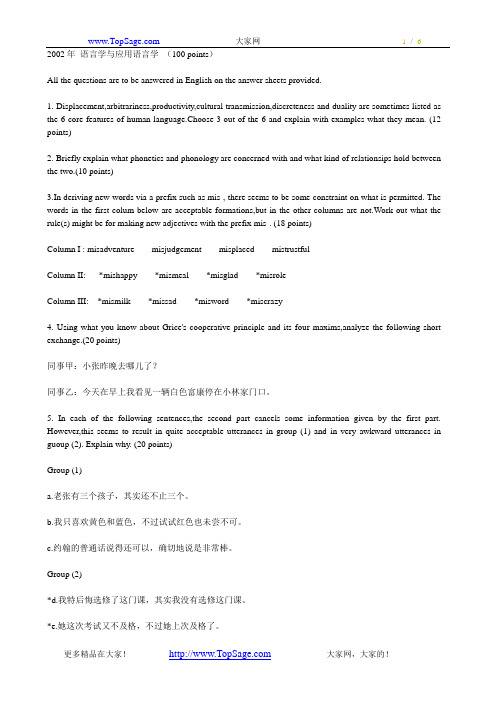
2002年语言学与应用语言学(100 points)All the questions are to be answered in English on the answer sheets provided.1. Displacement,arbitrariness,productivity,cultural transmission,discreteness and duality are sometimes listed as the 6 core features of human language.Choose 3 out of the 6 and explain with examples what they mean. (12 points)2. Briefly explain what phonetics and phonology are concerned with and what kind of relationsips hold between the two.(10 points)3.In deriving new words via a prefix such as mis-, there seems to be some constraint on what is permitted. The words in the first colum below are acceptable formations,but in the other columns are not.Work out what the rule(s) might be for making new adjectives with the prefix mis-. (18 points)Column I : misadventure misjudgement misplaced mistrustfulColumn II: *mishappy *mismeal *misglad *misroleColumn III: *mismilk *missad *misword *miscrazy4. Using what you know about Grice's cooperative principle and its four maxims,analyze the following short exchange.(20 points)同事甲:小张昨晚去哪儿了?同事乙:今天在早上我看见一辆白色富康停在小林家门口。
北京外国语大学(已有10试题)
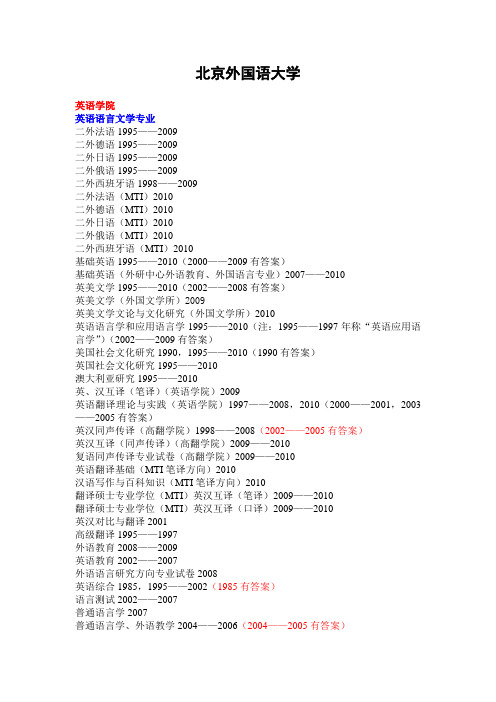
北京外国语大学英语学院英语语言文学专业二外法语1995——2009二外德语1995——2009二外日语1995——2009二外俄语1995——2009二外西班牙语1998——2009二外法语(MTI)2010二外德语(MTI)2010二外日语(MTI)2010二外俄语(MTI)2010二外西班牙语(MTI)2010基础英语1995——2010(2000——2009有答案)基础英语(外研中心外语教育、外国语言专业)2007——2010英美文学1995——2010(2002——2008有答案)英美文学(外国文学所)2009英美文学文论与文化研究(外国文学所)2010英语语言学和应用语言学1995——2010(注:1995——1997年称“英语应用语言学”)(2002——2009有答案)美国社会文化研究1990,1995——2010(1990有答案)英国社会文化研究1995——2010澳大利亚研究1995——2010英、汉互译(笔译)(英语学院)2009英语翻译理论与实践(英语学院)1997——2008,2010(2000——2001,2003——2005有答案)英汉同声传译(高翻学院)1998——2008(2002——2005有答案)英汉互译(同声传译)(高翻学院)2009——2010复语同声传译专业试卷(高翻学院)2009——2010英语翻译基础(MTI笔译方向)2010汉语写作与百科知识(MTI笔译方向)2010翻译硕士专业学位(MTI)英汉互译(笔译)2009——2010翻译硕士专业学位(MTI)英汉互译(口译)2009——2010英汉对比与翻译2001高级翻译1995——1997外语教育2008——2009英语教育2002——2007外语语言研究方向专业试卷2008英语综合1985,1995——2002(1985有答案)语言测试2002——2007普通语言学2007普通语言学、外语教学2004——2006(2004——2005有答案)普通语言学及应用语言学(外研中心)2010句法、第二语言习得2003综合考试(含国际政治、汉语)2000——2002英语新闻业务与新闻学基础知识2006——2009国际新闻2010国际法学专业(无此试卷)外交学专业综合考试(含国际政治、汉语)2000——2002中国外语教育研究中心外国语语言学及应用语言学专业二外法语1995——2009二外德语1995——2009二外日语1995——2009二外俄语1995——2009二外西班牙语1998——2009二外法语(MTI)2010二外德语(MTI)2010二外日语(MTI)2010二外俄语(MTI)2010二外西班牙语(MTI)2010基础英语1995——2010(2000——2009有答案)基础英语(外研中心外语教育、外国语言专业)2007——2010英美文学1995——2010(2002——2008有答案)英美文学(外国文学所)2009英美文学文论与文化研究(外国文学所)2010英语语言学和应用语言学1995——2010(注:1995——1997年称“英语应用语言学”)(2002——2009有答案)美国社会文化研究1990,1995——2010(1990有答案)英国社会文化研究1995——2010澳大利亚研究1995——2010英、汉互译(笔译)(英语学院)2009英语翻译理论与实践(英语学院)1997——2008,2010(2000——2001,2003——2005有答案)英汉同声传译(高翻学院)1998——2008(2002——2005有答案)英汉互译(同声传译)(高翻学院)2009——2010复语同声传译专业试卷(高翻学院)2009——2010英语翻译基础(MTI笔译方向)2010汉语写作与百科知识(MTI笔译方向)2010翻译硕士专业学位(MTI)英汉互译(笔译)2009——2010翻译硕士专业学位(MTI)英汉互译(口译)2009——2010英汉对比与翻译2001高级翻译1995——1997外语教育2008——2009英语教育2002——2007外语语言研究方向专业试卷2008英语综合1985,1995——2002(1985有答案)文化语言学2007语言测试2002——2007普通语言学2007普通语言学、外语教学2004——2006(2004——2005有答案)普通语言学及应用语言学(外研中心)2010句法、第二语言习得2003综合考试(含国际政治、汉语)2000——2002外国文学所英语语言文学专业二外法语1995——2009二外德语1995——2009二外日语1995——2009二外俄语1995——2009二外西班牙语1998——2009二外法语(MTI)2010二外德语(MTI)2010二外日语(MTI)2010二外俄语(MTI)2010二外西班牙语(MTI)2010基础英语1995——2010(2000——2009有答案)基础英语(外研中心外语教育、外国语言专业)2007——2010英美文学1995——2010(2002——2008有答案)英美文学(外国文学所)2009英美文学文论与文化研究(外国文学所)2010英语语言学和应用语言学1995——2010(注:1995——1997年称“英语应用语言学”)(2002——2009有答案)美国社会文化研究1990,1995——2010(1990有答案)英国社会文化研究1995——2010澳大利亚研究1995——2010英、汉互译(笔译)(英语学院)2009英语翻译理论与实践(英语学院)1997——2008,2010(2000——2001,2003——2005有答案)英汉同声传译(高翻学院)1998——2008(2002——2005有答案)英汉互译(同声传译)(高翻学院)2009——2010复语同声传译专业试卷(高翻学院)2009——2010英语翻译基础(MTI笔译方向)2010汉语写作与百科知识(MTI笔译方向)2010翻译硕士专业学位(MTI)英汉互译(笔译)2009——2010翻译硕士专业学位(MTI)英汉互译(口译)2009——2010英汉对比与翻译2001高级翻译1995——1997外语教育2008——2009英语教育2002——2007外语语言研究方向专业试卷2008英语综合1985,1995——2002(1985有答案)语言测试2002——2007普通语言学2007普通语言学、外语教学2004——2006(2004——2005有答案)普通语言学及应用语言学(外研中心)2010句法、第二语言习得2003综合考试(含国际政治、汉语)2000——2002德语语言文学专业二外英语1997——2003(2000——2003有答案)德国外交经济2000——2005德国文学2001——2005德语翻译理论与实践2000——2005基础德语2000——2005德语教学法2004——2005德语跨文化经济交际2000——2005德语语言学2000——2005国际问题研究所外交学专业综合考试(含国际政治、汉语)2000——2002社会科学部外交学专业综合考试(含国际政治、汉语)2000——2002国际商学院外交学专业综合考试(含国际政治、汉语)2000——2002俄语学院俄语语言文学专业二外英语1997——2003(2000——2003有答案)俄罗斯社会与文化2002——2003,2005俄罗斯文学2002——2005俄语翻译2004俄语翻译技巧2002翻译理论(俄语专业)2003俄语翻译理论与实践2005俄语基础2004——2005俄语语言学基础理论2002——2004现代俄语语言学2005俄语综合2002法语系法语语言文学专业二外英语1997——2003(2000——2003有答案)欧洲语言学专业二外英语1997——2003(2000——2003有答案)德语系德语语言文学专业二外英语1997——2003(2000——2003有答案)德国外交经济2000——2005德国文学2001——2005德语翻译理论与实践2000——2005基础德语2000——2005德语教学法2004——2005德语跨文化经济交际2000——2005德语语言学2000——2005日语系日语语言文学专业二外英语1997——2003(2000——2003有答案)日本社会文化2004(日语系)日本语言文学2004(日语系)以下试卷为日研中心试卷,仅供参考:专业日语2009(2009有答案)基础日语1997——2006,2008——2009(2000——2006,2008——2009有答案)日本概况2003——2005(2003——2005有答案)日本社会1997——2004(2000——2004有答案)日本社会经济2008(2008有答案)日本社会日本经济2005——2006(2005——2006有答案)日本文化1997——2004,2008(2000——2004,2008有答案)日本文学1997——2004,2008(2000——2004,2008有答案)日本文学日本文化2005——2006(2005——2006有答案)日本语言1997——2004(2000——2004有答案)日本语教育2008(2008答案)日本语言日本教育2005——2006(2005——2006有答案)日本语学2008(2008有答案)综合考试(日语专业)1997——2002(2000——2002有答案)日研中心日语语言文学专业二外英语1997——2003(2000——2003有答案)专业日语2009(2009有答案)基础日语1997——2006,2008——2009(2000——2006,2008——2009有答案)日本概况2003——2005(2003——2005有答案)日本社会1997——2004(2000——2004有答案)日本社会经济2008(2008有答案)日本社会日本经济2005——2006(2005——2006有答案)日本文化1997——2004,2008(2000——2004,2008有答案)日本文学1997——2004,2008(2000——2004,2008有答案)日本文学日本文化2005——2006(2005——2006有答案)日本语言1997——2004(2000——2004有答案)日本语教育2008(2008答案)日本语言日本教育2005——2006(2005——2006有答案)日本语学2008(2008有答案)综合考试(日语专业)1997——2002(2000——2002有答案)西葡系西班牙语语言文学专业二外英语1997——2003(2000——2003有答案)西班牙语基础2003——2004(其中2004年的试卷共12页,缺P11-12)西班牙语专业2003——2004欧洲语言学专业二外英语1997——2003(2000——2003有答案)阿语系阿拉伯语语言文学专业二外英语1997——2003(2000——2003有答案)欧洲语系欧洲语言文学专业二外英语1997——2003(2000——2003有答案)亚非语系亚非语言文学专业(无此试卷)国际交流学院语言学及应用语言学专业比较文学概论2004海外汉学2003——2004现代汉语1999古代汉语1999综合考试(含国际政治、汉语)2000——2002综合考试(含古代汉语、古代文学、现当代文学)2001中国历史文化2001历史文化综合1999——2000语言学与应用语言学专业综合2000语言学及现代汉语2000——2001比较文学与世界文学专业比较文学概论2004海外汉学2003——2004中国古代文学专业综合考试(含古代汉语、古代文学、现当代文学)2001高翻学院外国语语言学及应用语言学专业二外法语1995——2009二外德语1995——2009二外日语1995——2009二外俄语1995——2009二外西班牙语1998——2009二外法语(MTI)2010二外德语(MTI)2010二外日语(MTI)2010二外俄语(MTI)2010二外西班牙语(MTI)2010基础英语1995——2010(2000——2009有答案)基础英语(外研中心外语教育、外国语言专业)2007——2010英汉互译(同声传译)(高翻学院)2009——2010英汉同声传译(高翻学院)1998——2008(2002——2005有答案)英、汉互译(笔译)(英语学院)2009英语翻译理论与实践(英语学院)1997——2008,2010(2000——2001,2003——2005有答案)复语同声传译专业试卷(高翻学院)2009——2010英语翻译基础(MTI笔译方向)2010汉语写作与百科知识(MTI笔译方向)2010翻译硕士专业学位(MTI)英汉互译(笔译)2009——2010翻译硕士专业学位(MTI)英汉互译(口译)2009——2010英汉对比与翻译2001高级翻译1995——1997外语教育2008——2009英语教育2002——2007外语语言研究方向专业试卷2008英语综合1985,1995——2002(1985有答案)语言测试2002——2007普通语言学2007普通语言学、外语教学2004——2006(2004——2005有答案)普通语言学及应用语言学(外研中心)2010句法、第二语言习得2003综合考试(含国际政治、汉语)2000——2002英语语言学和应用语言学1995——2010(注:1995——1997年称“英语应用语言学”)(2002——2009有答案)。
北京第二外国语学院语言学及运用于用语言学考研参考书笔记
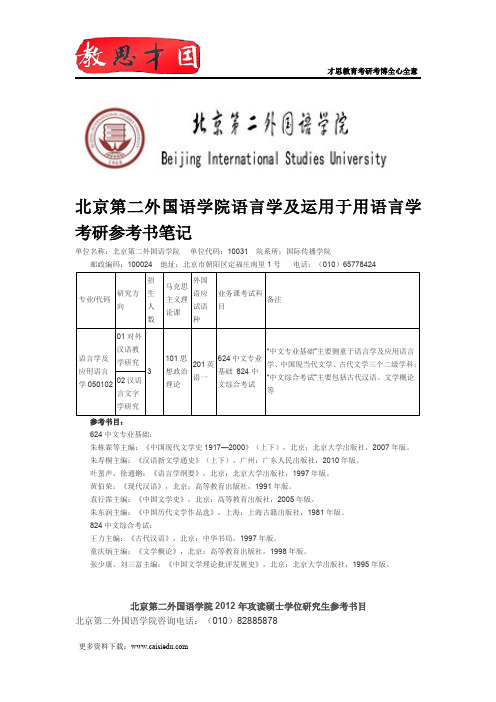
往》,北京大学出版社,2001
5.贾玉新:《跨文化交际学》,上海外语出版社,1998
(重点:第一、二、三部分)
日语语言文学参考书目:
615 基础日语:
《基础日语教程》(二、三、四册)潘寿君等 旅游教育出版社,2007.3
《日语高年级教程》(上下册)谢为集等 北京大学出版社,2007.9
815 综合考试(日):
3.《韩国社会与文化》(韩文),李承梅 等编著,青岛海洋大学出版社,2007 年。
外国语言学及应用语言学参考书目: 611 基础英语:水平测试,无指定参考书。 812 综合考试(英 2): 《英汉-汉英应用翻译综合教程》,方梦之、毛忠明,上海外语教育出版社,2008 年。 《英语国家社会与文化入门》,朱永涛等,高等教育出版社,第二版。 复试参考书: 01 国际商务英语: 《国际贸易》,薛荣久,对外经济贸易大学出版社,2003 年。
更多资料下载:
才思教育考研考博全心全意
《俄罗斯文化》 戴桂菊 外语教学与研究出版社 2010-3-1
法语语言文学参考书目:
616 基础法语:水平测试,无指定参考书
816 综合考试(法):
《法国文学史 上下卷》,郑克鲁,上海外语教育出版社,2003 年。
《欧洲文化入门》,王佐良,外语教学与研究出版社,2004 年。
复试参考书: 无指定参考书,但要关注时事(中英文)。
注:该专业统考科目不含第二外语,但复试过程中将有第二外语口语和听力测试,考试形式 为对话问答。我校二外语测试的科目为二外日语、二外法语、二外德语、二外俄语和二外西 班牙语,考生可任选一门参加考试,入学后考生按照选定的二外语科目参加二外语学习。
工商管理硕士、旅游管理硕士无指定参考书目
北京外国语大学2007年语言学考研真题
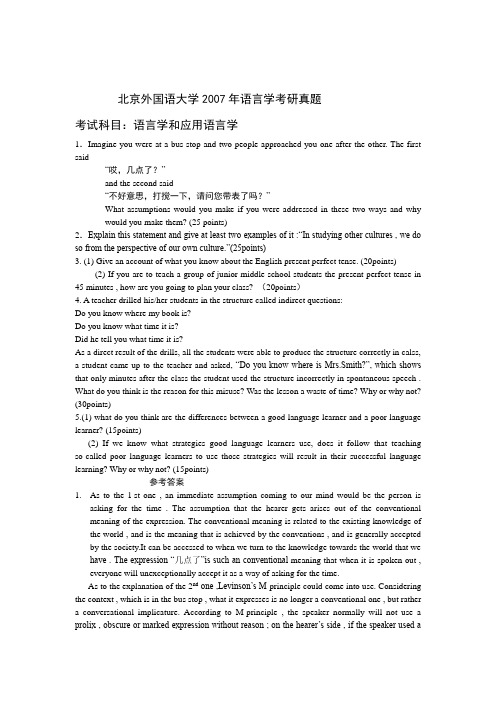
北京外国语大学2007年语言学考研真题考试科目:语言学和应用语言学1.Imagine you were at a bus stop and two people approached you one after the other. The first said“哎,几点了?”and the second said“不好意思,打搅一下,请问您带表了吗?”What assumptions would you make if you were addressed in these two ways and why would you make them? (25 points)2.Explain this statement and give at least two examples of it :“In studying other cultures , we do so from the perspective of our own culture.”(25points)3. (1) Give an account of what you know about the English present perfect tense. (20points)(2) If you are to teach a group of junior middle school students the present perfect tense in 45 minutes , how are you going to plan your class? (20points)4. A teacher drilled his/her students in the structure called indirect questions:Do you know where my book is?Do you know what time it is?Did he tell you what time it is?As a direct result of the drills, all the students were able to produce the structure correctly in calss, a student came up to the teacher and asked, “Do you know where is Mrs.Smith?”, which shows that only minutes after the class the student used the structure incorrectly in spontaneous speech . What do you think is the reason for this misuse? Was the lesson a waste of time? Why or why not? (30points)5.(1) what do you think are the differences between a good language learner and a poor language learner? (15points)(2) If we know what strategies good language learners use, does it follow that teaching so-called poor language learners to use those strategies will result in their successful language learning? Why or why not? (15points)参考答案1.As to the 1st one , an immediate assumption coming to our mind would be the person isasking for the time . The assumption that the hearer gets arises out of the conventional meaning of the expression. The conventional meaning is related to the existing knowledge of the world , and is the meaning that is achieved by the conventions , and is generally accepted by the society.It can be accessed to when we turn to the knowledge towards the world that we have . The expression “几点了”is such an conventional meaning that when it is spoken out , everyone will unexceptionally accept it as a way of asking for the time.As to the explanation of the 2nd one ,Levinson’s M-principle could come into use. Considering the context , which is in the bus stop , what it expresses is no longer a conventional one , but rather a conversational implicature. According to M-principle , the speaker normally will not use a prolix , obscure or marked expression without reason ; on the hearer’s side , if the speaker used aprolix or marked expression , he did not mean the same as he would have had when he used the unmarked expression. That is to say , in the normal situation , in the bus stop as the example above has shown , the intention of that the speaker asks others whether they wear the watch or not is not merely to care about the recipient has a watch or not , but has some other reason , because it would be bizarre to ask a stranger in the bus stop about such a personal staff. Therefore ,the hearer has to assume that the expression is related to the situation , and this expression is not what it literally mean. Following this , the hearer reaches a connection between the bus stop and the watch , that is the time. As s consequence , he knows what the speaker intends is the inquiring of the time.2. Culture is a semiotic meaning system in which symbols function to communicate meaning from one mind to another. It is related to language in such a way that language is a part of culture and a part of human behavior , and also the primary medium for transmitting much of culture. Therefore , without language , culture would not be possible . Consequently , when studying a culture , we often rely on the language . Therefore , we may use our own language to describe the target culture , which may be the one interpretation of the statement “In studying other cultures , we do so from the perspective of our own culture .”What’s more , when studying other cultures , we will definitely come across the differences between the target culture and our own culture. We will subconsciously compare the two different cultures . Seeing from the perspective of our own culture ,we find how the target culture is different from our own culture, and this makes the target culture more distinctive from our own .3. (1) The English present perfect tense is to express the idea that although an action or state happened (or started to happen ) in the past , it has some connection with the present . It may be that the ( present ) result of the action is more important than the action itself . Alternatively , we may be inferring that the action is important , but the time when it occurred is not .(2) I may probably choose the top-down approach to lead the students to the recognition of this tense .First , I will list out a group of sentences that are all in the present perfect tense , and make the students generalize the general feature in the form of those sentences , and figure out the basic construction of the present perfect tense , that is “have + V-en ”.Second , to make the students clear about the conditions in which the present perfect tense can use , I would turn to pictures to explain the sentences listed out in the 1st step ; therefore , the students can find out the use of this tense in a more visual way .Third , considering the possibility that the students may mix up the present perfect tense with the past tense , I would help students figure out their differences . In this step , pairs of sentences with present perfect tense and past simple tense respectively would be listed out , and accompanying them would be the time axis , which could distinguish the different referring of the two different tenses . The students would found out the differences themselves with the help of the time axis .Forth , I would create a situation for the students to practice : two friends who haven’t seen each other for a long time and just met each other . I would encourage the students to make up a dialogue based on such a situation , trying to use the present perfect tense in the places where they think it is appropriate to use it . After students show their dialogue to the class , the class would be asked to decide whether the use of that tense is appropriate according to what they expressed .4. The misuse shows a separation of the abstract grammatical rules from the everyday use of language . The core of the teaching method above could be said as the habit formation throughrepetition . This method seems to concerns only the formation and performance of habits but not problem-solving . As a result , the students may only know the form ,but not know when and where this form is used , which is essential to the actual use of language . This type of teaching reveals the defect of the traditional grammar teaching , that is,it concentrates only on the grammatical forms and the meaning of individual words , whereas the meaning of the whole sentence is thought to be self-evident . Therefore , in conscious training , students may be able to use a grammatical structure correctly , while in the spontaneous and subconscious speech , they may fail to still take the structure into consideration . In other words ,they may not know how to use that specific form or expression in a daily communication .The fact that this teaching method is not perfect does not mean that there is no need to teach the grammar . Therefore , it would be inappropriate to label such a lesson as a waste of time . It is true that the students should be taught how to produce appropriate utterances given a communicative situation ; yet , they have to know the correct form first , which is greatly related to grammar . It is generally agreed grammar has its due value in language learning .What’s more , there can be some improvements to this lesson . It would be appreciated to add the communicative oriented tasks in it , which will make the students understand more clearly the situations the pattern is supposed to used in , and also help the students apply them to the spontaneous communication .5. (1) The difference between the good language learners and the poor language learners significantly lies in the difference of learning strategies.The good language learners are able to use their strategies effectively . They could actively involve themselves in the language learning process by identifying and seeking preferred learning environments and exploring them . They could also develop an awareness of language as a system , and as a means of communication and interaction . What’s more , they could realize initially or with time that they must cope with the affective demands made upon them by language learning and succeed in doing so , and then monitor the performance in the target language . Whereas , the poor language learners are often unable to use the strategies appropriately .(2) It would be wrong to assume that the strategies good language learners use will result in success for the poor language learners if they follow those strategies , because language learning has individual differences . For example , everyone has his own learning style . There are generally three types of learning style , namely , visual , auditory , and tactile . We could assume that the good language learner is a more visual learner , which means he learns faster and better from visual displays including : diagrams , illustrated text books , overhead transparencies , videos , flipcharts and handouts . However , the contrasting poor learner is of every possibility more an auditory learner than a visual one , which means they can learn their best through verbal lectures , discussions , talking things through and listening to what others have to say , and written information may have little meaning until it is heard . Therefore , the strategies the good language learner uses will be more visual than auditory , which is obviously not applicable to the poor language learner . Thus , the individual differences should be taken into consideration in following other s’ learning strategies .。
2002年北京外国语大学二外法语真题及详解【圣才出品】
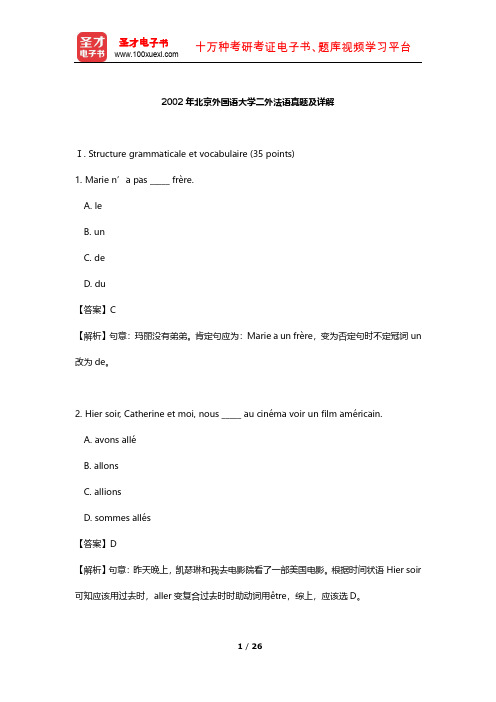
2002年北京外国语大学二外法语真题及详解Ⅰ. Structure grammaticale et vocabulaire (35 points)1. Marie n’a pas _____ frère.A. leB. unC. deD. du【答案】C【解析】句意:玛丽没有弟弟。
肯定句应为:Marie a un frère,变为否定句时不定冠词un 改为de。
2. Hier soir, Catherine et moi, nous _____ au cinéma voir un film américain.A. avons alléB. allonsC. allionsD. sommes allés【答案】D【解析】句意:昨天晚上,凯瑟琳和我去电影院看了一部美国电影。
根据时间状语Hier soir 可知应该用过去时,aller变复合过去时时助动词用être,综上,应该选D。
3. Si mes camarades étaient là, ils m’_____.A. aidaientB. aidentC. aiderontD. aideraient【答案】D【解析】句意:如果我的同事在那里,他们会帮助我的。
与现在事实相反的假设,主句用条件式现在时,从句用未完成过去时。
4. Je vais aller _____ Paris dans trois jours.A. àB. enC. auD. chez【答案】A【解析】句意:三天后我将去巴黎。
城市前介词用à。
5. A midi, j’ai mangé_____ viande.A. laB. de laC. leD. du【答案】B【解析】句意:中午我吃了肉。
viande是阴性集合名词,介词用de la。
6. Après la classe _____ jouer au basket-ball avec les autres, ces trois étudiants sont restés dans la classe pour finir leurs devoirs.A. au lieu deB. loin deC. sansD. faute de【答案】A【解析】句意:下课后,这三个学生没有去打篮球,他们留在教室为了完成作业。
北京外国语大学2005年语言学考研真题
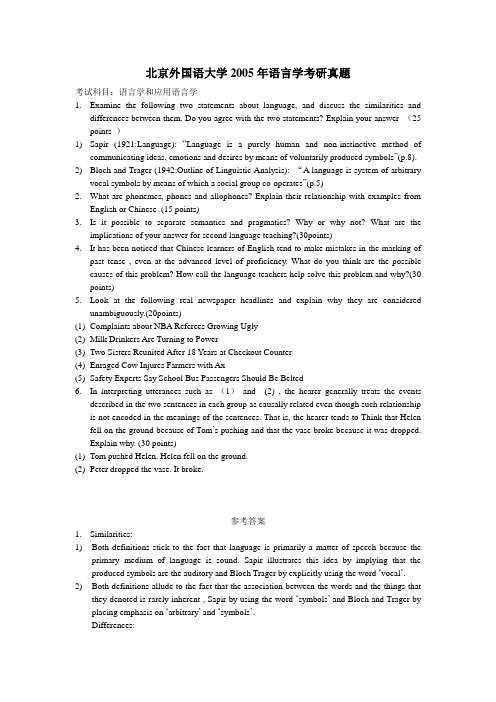
北京外国语大学2005年语言学考研真题考试科目:语言学和应用语言学1.Examine the following two statements about language, and discuss the similarities anddifferences between them. Do you agree with the two statements? Explain your answer (25 points )1)Sapir (1921:Language): “Language is a purely human and non-instinctive method ofcommunicating ideas, emotions and desires by means of voluntarily produced symbols”(p.8).2)Bloch and Trager (1942:Outline of Linguistic Analysis): “A language is system of arbitraryvocal symbols by means of which a social group co-operates”(p.5)2.What are phonemes, phones and allophones? Explain their relationship with examples fromEnglish or Chinese .(15 points)3.Is it possible to separate semantics and pragmatics? Why or why not? What are theimplications of your answer for second language teaching?(30points)4.It has been noticed that Chinese learners of English tend to make mistakes in the marking ofpast tense , even at the advanced level of proficiency. What do you think are the possible causes of this problem? How call the language teachers help solve this problem and why?(30 points)5.Look at the following real newspaper headlines and explain why they are consideredunambiguously.(20points)(1)Complaints about NBA Referees Growing Ugly(2)Milk Drinkers Are Turning to Power(3)Two Sisters Reunited After 18 Years at Checkout Counter(4)Enraged Cow Injures Farmers with Ax(5)Safety Experts Say School Bus Passengers Should Be Belted6.In interpreting utterances such as (1)and (2) , the hearer generally treats the eventsdescribed in the two sentences in each group as causally related even though such relationship is not encoded in the meanings of the sentences. That is, the hearer tends to Think that Helen fell on the ground because of Tom‟s pushing and that the vase broke because it was dropped.Explain why. (30 points)(1)Tom pushed Helen. Helen fell on the ground.(2)Peter dropped the vase. It broke.参考答案1.Similarities:1)Both definitions stick to the fact that language is primarily a matter of speech because theprimary medium of language is sound. Sapir illustrates this idea by implying that the produced symbols are the auditory and Bloch Trager by explicitly using the word …vocal‟. 2)Both definitions allude to the fact that the association between the words and the things thatthey denoted is rarely inherent , Sapir by using the word …symbols‟ and Bloch and Trager by placing emphasis on …arbitrary‟ and …symbols‟.Differences:1)Sapir‟s definition emphasize that language relates to communication between human beings.It‟s very different from the communication systems of other creature,such as bird songs and bee dances. Bloch and Trager do not clearly indicate this property, only saying that it is possessed by a social group.2)Sapir also considers that language is …non-instinctive‟and …voluntarily produced‟. Thus for him language does not include such instinctive forms of communication as smiling and cries of pain,etc. However, Bloch and Trager‟s definition do not include this feature.3)The element …system‟ in Bloch and Trager‟s definition reflects the fact that language provides us with the framework for generating appropriate utterances rather than providing us with an infinite store of ready-made utterances. Still elements of lacunae are combined according to rules.4)The function of language is indicated differently in two definitions. Sapir sees language as for communicating ideas, emotions and definition proposes …communication‟as the principal function of language and specifies what is communicated; Bloch and Trager only vaguely points out that language can be used for co-operation.Each of the two definitions has its own special emphasis, and is not totally free from limitations. We think the two definitions grasp some defining properties of language that distinguish it from any animal system of communication, for example, …vocal‟, …arbitrary‟, …symbol‟, …purely human‟, …a system‟. But either has some limitation. As for Sapir‟s definition, whether one considers language to be instinctive or not is an issue. Language is instinctive in so far as we are all born with a predisposition to speak, we all acquire a language without tuition and when we speak we do not consciously convert our thoughts into speech. Language is, however, non-instinctive in that we can choose what to say or whether to say anything at all. Both the definition‟s description of language‟s function is not precise. Sapir‟s definition confines language only to communicating ideas, emotions and desires, and Bloch and Trager‟s definition does not point it out at all.2. A phoneme is a minimally distinctive set of sounds in a language that can signal a difference in meaning. It is an abstract phonological unit represented or realized by a certain phone in a certain phonetic context. A phone is an individual phonetic unit or segment that occurs in speech. The speech sounds we hear and produce during linguistic communication are all phones. Each of the set of phones which correspond to a single phoneme of a language is called an allophone. Phonemes are placed between slant lines (//)and phones are placed between square brackets ([]). Allophones of the same phoneme generally occur in different contexts and never distinguish one word from another. For example, when we pronounce the two words peak and speak, we are aware that the sound [p] is pronounced differently, in the word peak, the sound [p] is pronounced with a strong puff of air stream; but the same step sounds is pronounced slightly differently in the word speak, the puff of air is withheld a little. The [p] sound in peak is called an aspirated [ph] and the [p] sound in speak is an exasperated [p=]. There is a slight difference in the way they are pronounced, but such a difference does not give rise to difference in meaning. So /p/is a phoneme in the English sound system, and it can be realized differently as aspirated or exasperated in different contexts. The phoneme/p/in English can be realized as aspirated [ph] and unaspirated [p=], which are allophones of the phoneme/p/.3. Though both semantics and pragmatics have something to do with the meaning of language,and link language to the world, we think it is possible to separate semantics and pragmatics in linguistic study. Semantics is the study of literal meaning of linguistic expression, particularly meaning of words, phrases and sentences. In using the term sense rather than reference, the focus of semantics is on the way people relate words to each other within the framework of their language. Pragmatics starts from the observation that people use language to accomplish many kinds of acts, broadly known as speech acts;thus it is the study of how to do things with words or of the meaning of language in context. This kind of meaning in pragmatics is usually referred to as speaker‟s meaning, utterance meaning, or contextual meaning. Its interpretation depends more on who the speaker of the sentence is, who the hearer is, when and where it is used. Thus the distinction between semantics and pragmatics is clear: the former is more closely related to the words used, the more constant, inherent side of meanings; the latter is more closely related to the context, the more indeterminate side, or something extra.The first implication for second language study involves the appropriate use of target language. The teaching of a foreign language in a classroom involves two types of instruction: one is informational and analytical and can be diagrammed on the axis of general semantic information about the language. But language learning also has a crucially important skill component, which involves the development of the ability to use the language, actively through speaking and writing and passively through listening and reading. This is the pragmatic turn in second language teaching. The language use should be analyzed in relation to the context of communication, and that language teaching and learning should focus on the appropriate use of the target language, oral and written, according to situational and wider social context.The second implication is concerned with vocabulary learning and translation. The learning of second language‟s vocabularies involves the understanding and memory of their meanings. Because of the differences between the first and second language‟s culture, there may be no corresponding meaning underlying the same sayings. Teachers should explain the different usage or implication of the target language‟s items. This is of much importance for cross-cultural translation practices.4.Tenses are one of the most different aspects for Chinese to master because of the non-inflection nature of the Chinese language in English, the different forms of the verb can tell us whether something is happening in the present or in the past. This information is technically termed as tense. The tense is shown by adding related morphemes at the end of the verb. So the learners can judge the tense easily by looking at the different verb forms. However, the Chinese verb does not have a well defined past, present or future tense. In writing or in speaking, the Chinese verb in the sentence does not necessarily inform the reader or listener as to whether they are referring to the past, present or future. Therefore, Chinese often places prepositional, phrases, as well as conjunctive adverbs (e.g. Mandarin Chinese le, guo) that indicate time at the front of the sentence so as to inform the speaker or the reader of the appropriate tense. The different ways of expressing the tense cause Chinese learners of English tend to make mistakes in the marking of tense. When translating into English, Chinese writers sometimes forget that English has a well-defined past /present /future verb tense. Therefore, the unconscious tendency of placing several prepositional or other phrase that indicate time at the front of the sentence is often redundant or they might neglect using different tense form of verb. Another factor which contributes to the difficulties is the difference in the concept of time of Chinese as compared to native speakers of English. Different concepts of time of non-native speakers with those of native speakers contribute to theirdifficulties in learning the English tenses.As the learning of tense, Chinese learners faced with a totally new set of classification of time situation that have no counterpart in their own native language. So in teaching English tenses teachers have to explain English time attributes thoroughly rather than assuming L2 learners will understand them as long as they have acquired the rules. For example, past tense is used for situations which are less probable, or more remote. A lot of Chinese do not have this concept and teachers should spend time in clarifying this to them. Teachers can also allow learners to understand the meanings of the two broad types of English and Chinese tense and their differences in teaching Chinese learners. Through the comparison of different ways of expressing tense, the teacher can provide the students a clear framework and then students will take special notice in using verb associated with tense.5.(1)There are two kinds of comprehension of this headline: the first is “Complaints about NBA Referees are Growing Ugly.” this with nominal group as the subject and present tense verb is modifying …complaints‟: the second is “Complaints about NBA Referees Who Are Growing Ugly”, thus the whole headline is a nominal group and the present tense verb modify …NBA Referees‟. We think the first interpretation is the intended meaning, thus the original headline is revised to “Complaints about NBA Referees Are Growing Ugly”.(2)The word …powder‟is ambiguous in meaning here, because it can imply the drug or medicine in the form of powder. Thus in order to be clear in meaning, the original headline can be revised into “Mike Drinkers Are Turing to Milk Powder”.(3)There are two kinds of interpretation of this headline: the first is “two sister reunited at checkout counter after 18 years of separation.”The second interpretation is that “two sisters reunited after they have been in checkout counter for 18 years.”The more reasonable meaning could probably be the first one. Therefore, the original headline can be revised into “Two Sister Reunited At Checkout Counter After 18 Years.”(4)There are two kinds of interpretations of this headline: the first is “ Enrages Cow Injures Farmer Who Is With Ax” thus the prepositional group is modifying the compliment …farmer‟; the second is “Enraged Cow Which Is With Ax Injures Farmer”thus the prepositional group is modifying the subject …enraged cow‟. However, according to the common sense, the second interpretation doesn‟t occur naturally, and we think the first interpretation is the intended meaning. The original headline can be revised to “Enraged Cow Injures Farmer who is with Ax”.(5) The word …belt‟is ambiguous in meaning because it can mean the act of hitting or blowing hard. Thus the original headline can be revised into “Safety Experts Say School Bus Passengers‟ Safety Belt Should Put on Safety Belt.‟6.The phenomenon described can be illustrated by the theory of cohesion and coherence in discourse analysis, especially the conjunctive kind of cohesive relation. Text processing requires inferences for establishing coherence between successive sentences. The achievement of coherence partly through grammatical device and partly through lexical cohesion.Conjunction is one of the grammatically cohesive relations. It is based on the assumption that there are forms of systematic relationships between sentences in the linguistic system. Conjunction can be realized by some conjunctive words and some adverbs, such as so, but, furthermore, and so on. But in fact, the conjunctive relation between the discourse need not be realized by conjunctive words, as can be seen in these two examples.Yet it is not enough for the text to have connections between elements, there is also thecoherence which distinguishes connected texts which make sense from those which do not. It enables people to make sense of what they read and hear, and then try to arrive at an interpretation which is inline with their experience of the way the world is. In fact, our ability to make sense of what we read is probably only a small part of that general ability we have to make sense of what we experience or perceive in the world.Therefore, by the coherence which helps us to connect the discourse with the world we experience, we the hearers will tend to make the discourse fit in some situation which could accommodate all the details, and just as in the two examples ,the causal conjunctive relations are established.。
北京外国语大学02年语言学考研真题

北京外国语大学2002 年语言学考研真题考试科目:语言学和应用语言学1.Displacement, arbitrariness, cultural transmission, discreteness and dualityare sometimes listed as the 6 core feature of human language. Choose 3 out ofthe 6 and explain with examples what they mean. (12 points )2.Briefly explain what phonetics and phonology are concerned with and what kindof relationships hold between the two. (10 points )3.In deriving new words via a prefix such as mi-, there seems to be someconstraint on what is permitted. The words in the first column below areacceptable formation, but the forms in the other columns are not. Work outwhat the rules might be for making new adjectives with the suffix mis- (18points )Misadventure mishappymismilkMisjudgementmismealmissadMisplacemisglad miswordMistrustfulmisrulemiscrazing what you know about Grice ’scooperative principle and its four maxims,analyze the following short exchange. (20 points )同事甲:小张昨晚去哪儿了?同事乙:今天早上我看见一辆白色富康停在小林家门口。
语言学及应用语言学真题锦集
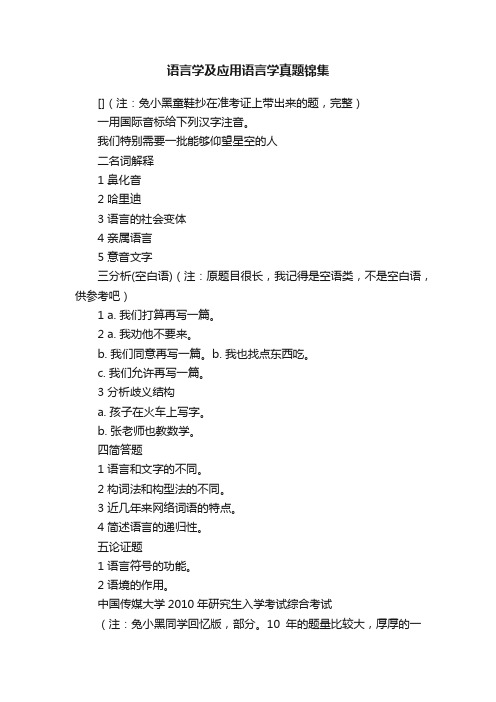
语言学及应用语言学真题锦集[](注:兔小黑童鞋抄在准考证上带出来的题,完整)一用国际音标给下列汉字注音。
我们特别需要一批能够仰望星空的人二名词解释1 鼻化音2 哈里迪3 语言的社会变体4 亲属语言5 意音文字三分析(空白语)(注:原题目很长,我记得是空语类,不是空白语,供参考吧)1 a. 我们打算再写一篇。
2 a. 我劝他不要来。
b. 我们同意再写一篇。
b. 我也找点东西吃。
c. 我们允许再写一篇。
3 分析歧义结构a. 孩子在火车上写字。
b. 张老师也教数学。
四简答题1 语言和文字的不同。
2 构词法和构型法的不同。
3 近几年来网络词语的特点。
4 简述语言的递归性。
五论证题1 语言符号的功能。
2 语境的作用。
中国传媒大学2010年研究生入学考试综合考试(注:兔小黑同学回忆版,部分。
10年的题量比较大,厚厚的一本试卷,不过答题时间应该是来得及的。
)现汉部分名词解释撮口呼句群通感区别词次方言构词方式脱贫特区离休飞播牵头简答题1调值和调类的关系2汉字标准化的内容3外来词类型4主语相对谓语动词有哪些语义关系类型古汉部分名词解释1隶变2古今字3章句4入声韵解释加点字,说明形旁和意义的关系古文加标点、翻译[/][]专业:语言学及应用语言学考试科目:语言学理论(总分150分,考试时间:3小时)一、术语解释(每条5分,共20分)1.克里奥尔语2.能指3.语言的地域变体4.历史比较语言学5.借源文字二、分析题(每题10分,共50分)1. 分析“饭卡、彩霞、航线、麻花”四个词语中八个音节的主要元音(韵腹)的音位及变体,并说明该变体产生的原因。
2.运用层次分析法画框式图的方式分析下列语言结构(要求分析到词)。
(1)英国科学家声称开发出可翻译外星人语言的计算机程序(2)建立汉语教师培训中心有助于中国文化在本地的发展3.识别下列语句中的歧义现象,并简述导致歧义的原因。
(1)小王说故事很有趣。
(2)连校长都不知道4.就“毕婚族、股民、晒工资、绿客、车奴、驴友、电话门”等分析现代汉语新词语现象。
北京外国语大学中国外语教育研究中心外国语言学及应用语言学历年考研真题及详解专业课考试试题
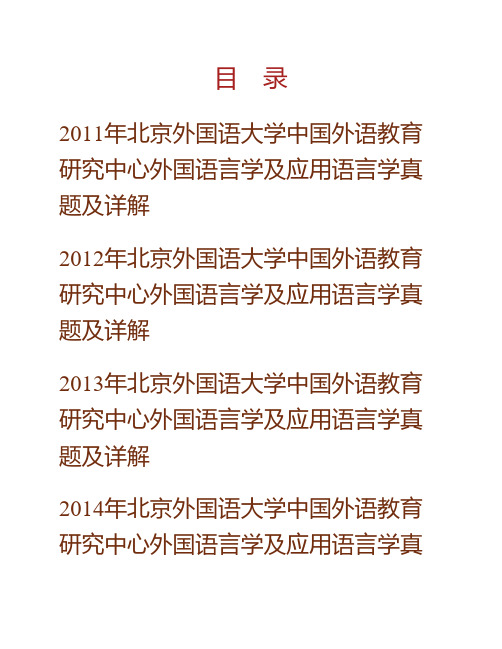
目 录2011年北京外国语大学中国外语教育研究中心外国语言学及应用语言学真题及详解2012年北京外国语大学中国外语教育研究中心外国语言学及应用语言学真题及详解2013年北京外国语大学中国外语教育研究中心外国语言学及应用语言学真题及详解2014年北京外国语大学中国外语教育研究中心外国语言学及应用语言学真题及详解2015年北京外国语大学中国外语教育研究中心外国语言学及应用语言学真题及详解2011年北京外国语大学中国外语教育研究中心外国语言学及应用语言学真题及详解I. Briefly explain the following terms. (20 points)1.perlocutionary act【答案】According to Austin, a speaker might be performing three acts simultaneously when speaking: locutionary act illocutionary act perlocutionary act. A perlocutionary act is the effect of the utterance. Thus, by saying “Morning!” the speaker has made it clear that he wants to keep friendly relations with the hearer.2.minimal pair【答案】Minimal pairs are the two words which are identical in every way except for one sound segment that occurs in the same place in the string. For example, the English words bear and pear constitute a minimal pair as they differ in meaning and in their initial phonemes /b/ and /p/.3.distinctive feature【答案】The distinctive feature refers to a property which distinguishes one phoneme from another. For example, “voicing” is a distinctive feature, since it plays an important role in distinguishing obstruents in English.4.linguistic variable【答案】Linguistic variable are those where the meaning remain constant but form varies like cat and pussy have the same social meaning but different form. So far pronunciation is concerned house [h] and with [h] has same social meaning with different pronunciation. Here variables are just the tools to analyze the language to set social dimensional society.5.lingua franca【答案】It is a language that is used for communication between different groups of people, each speaking a different language. The lingua franca couldbe an internationally used language of communication (e. g. English), it could be the native language of one of the groups, or it could be a language which is not spoken natively by any of the groups but has a simplified sentence structure and vocabulary and is often a mixture of two or more languages.II. Answer the following questions. (30 points)1.Why do we say linguistics is a science? (10 points)【答案】Linguistics is generally defined as the scientific study of language. It tries to answer the basic questions “What is language?” and “How does language work?” Linguistics studies not any particular language, e.g. English, Chinese, Arabic, and Latin, but it studies languages in general.It is a scientific study because it is based on the systematic investigation of linguistic data, conducted with reference to some general theory of language structure. In order to discover the nature and rules of the underlying language system, what the linguist has to do first is to collect and observe language facts, which arc found to display some similarities, and generalizations are made about them; then he formulates some hypotheses about the language structure. But the hypotheses thus formed have to be checked repeatedly against the observed facts to fully prove their validity. In linguistics, as in any other discipline, data and theory stand in a dialectical complementation; that is, a theory without the support of data can hardly claim validity, and data without being explained by some theory remain a muddled mass of things.(此题考查语言学作为一门学科其科学性,此题开放性试题,从其研究内容及方法角度作答即可。
2015年北二外语言学及应用语言学考研真题考研参考书,考研经验

第一,回答的视角要广,不要拘泥于一两个点。 第二,在回答论述题的时候一定要有条理性,但是条数不宜过多,在 5-8 条为主。字数 在 1500 左右。用时为 25-30 分钟。 (四)案例分析题 1.育明考研名师解析 案例分析与其说是在考察案例,不如说是再考察考生对核心理论和知识点的掌握。难度
《育明教育 135 分考研专业课答题攻略》
(一)名词解释 1.育明考研名师解析
名词解释一般都比较简单,是送分的题目。在复习的时候要把重点名词夯实。育明考研 专业课每个科目都有总结的重要名词,不妨作为复习的参考。
很多高校考研名词解释会重复,这就要考生在复习的同时要具备一套权威的、完整的近 5 年的真题,有近 10 年的最好。 2.育明考研答题攻略:名词解释三段论答题法 定义——》背景、特征、概念类比、案例——》总结/评价 第一,回答出名词本身的含义。一般都可以在书本找到。 第二,从名词的提出的背景、它的特征、相似概念比较等方面进行简述。 第三,总结,可以做一下简短的个人评价。 3.育明教育答题示范 例如:“战略人力资源管理” 第一,什么是战略人力资源管理(这是答案的核心) 第二,它的几个特征,并简单做一下解释。 第三,和职能人力资源管理,人事管理等进行对比。 4.危机应对
适中。但是很容易丢分,想要得高分,比较难。 2.育明考研答题攻略:案例分析两点分析法 理论结合——》案例分析 第一,对材料所涉及的问题寻找理论依据。 第二,结合材料进行分析 3.育明教育答题示范 例如:关于北京公交车现行的问题,运用公共政策知识分析。 第一,要精确找到所考察的知识点——政策工具。然后阐述什么事政策工具,包括哪些政策 工具,各自的优缺点是什么。 第二,结合材料进行分析。 4.危机应对
英语语言学考研真题与典型题详解
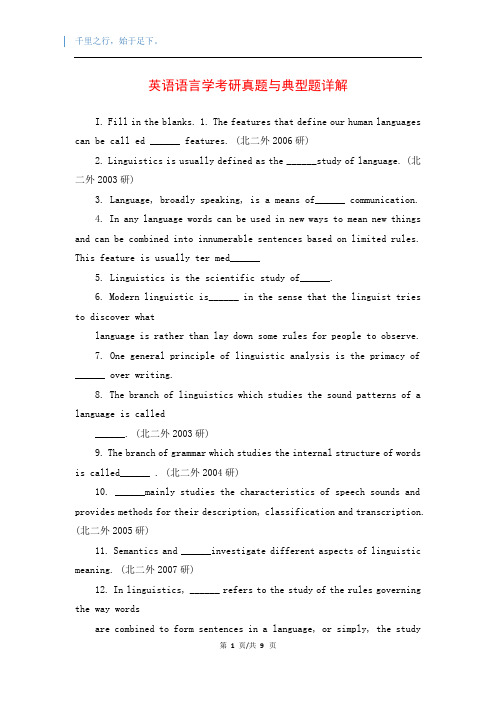
英语语言学考研真题与典型题详解I. Fill in the blanks. 1. The features that define our human languages can be call ed ______ features. (北二外2006研)2. Linguistics is usually defined as the ______study of language. (北二外2003研)3. Language, broadly speaking, is a means of______ communication.4. In any language words can be used in new ways to mean new things and can be combined into innumerable sentences based on limited rules. This feature is usually ter med______5. Linguistics is the scientific study of______.6. Modern linguistic is______ in the sense that the linguist tries to discover whatlanguage is rather than lay down some rules for people to observe.7. One general principle of linguistic analysis is the primacy of ______ over writing.8. The branch of linguistics which studies the sound patterns of a language is called______. (北二外2003研)9. The branch of grammar which studies the internal structure of words is called______ . (北二外2004研)10. ______mainly studies the characteristics of speech sounds and provides methods for their description, classification and transcription. (北二外2005研)11. Semantics and ______investigate different aspects of linguistic meaning. (北二外2007研)12. In linguistics, ______ refers to the study of the rules governing the way wordsare combined to form sentences in a language, or simply, the studyof the formation as sentence. (中山大学2008研)13. ______can be defined as the study of language in use. Sociolinguistics, on the other hand, attempts to show the relationship between language and society.14. The branch of grammar which studies the internal structure of sentence is called_______. (北二外2008研)15. Saussure distinguished the linguistic competence of the speaker and the actual ph enomena or data of linguistics (utterances) as and . The former refers to the abstract linguisticlinguistic system shared by all the members of a speech community, and the latter is the concrete manifestation of language either through speech or through writing. (人大2006研)16. The description of a language as it changes through time is a ______ study.17. Linguistic potential is similar to Saussure’s langue and Chomsky’s______.18. One of the important distinctions in linguistics is ______ and parole. The formeris the French word for “language”,which is the abstract knowledge necessary for s peaking,listening,writing and reading. The latter is concerned about the actual use of language by peop le in speech or writing. Parole is more variable and may change according to contextu al factors.19. One of the important distinctions in linguistics is and performance. (人大2006研)20. Chomsky initiated the distinction between ______ and performances. (北二外2007研)II. Multiple Choice1.Which of the following is NOT a frequently discussed design feature? (大连外国语学院2008研)A. ArbitrarinessB. ConventionC. Dualityof the following words is entirely arbitrary? (西安交大2008研)A. treeB. crashC. typewriterD. bang3. A linguist regards the changes in language and languages use as______.A. unnaturalB. something to be fearedC. naturalD. abnormal4. Which of the following property of language enables language users to overcome thebarriers caused by time and place, due to this feature of language, speakers of a language are free to talk about anything in any situation?A. Transferability.B. Duality.C. Displacement.D. Arbitrariness:5. The study of physical properties of the sounds produced in speech is closely con nected with______. (大连外国语学院2008研)A. articulatory phoneticsB. acoustic phoneticsC. auditory phonetics6. Which of the following statements is true of Jacobson’s framework of language func tions?A. The referential function is to indulge in language for its own sake.B. The emo tive function is to convey message and information.C. The conative function is to clear up intentions, words and meanings.D. The phat ic function is to establish communion with others.of the following is a main branch of linguistics? (大连外国语学院2008研)A. MacrolinguisticsB. PsycholinguisticsC. Sociolinguistics8. ______ refers to the system of a language, i. e. the arrangement of sounds and w ords which speakers of a language have a shared knowledge of. (西安外国语学院2006研) A. Langue B. Competence C. Communicative competence D. Linguistic potentialstudy of language at one point in time is a _______ study. (北二外2010研)A. historicalB. synchronicC. descriptiveD. diachronic10. “An refer to Confucius even though he was dead 2,000 years ago. ”This shows that language has the design feature of _____.A. arbitrarinessB. creativityC. dualityD. displacement11. The function of the sentence “Water b oils at 100 degreeCentigrade”is .A. interrogativeB. directiveC. informativeD. performative is closely connected with ______. (大连外国语学院2008研) A. Langue B. Competence C. EticIII. True or False1. Onomatopoeic words can show the arbitrary nature of language. (清华2000研)2. Competence and performance refer respectively to a language user’s underlying knowle dge about the system of rules and the actual use of language in concrete situations.3. Language is a means of verbal communication. Therefore, the communication way usedby the deaf-mute is not language4. Arbitrariness of language makes it potentially cre ative, and conventionality of language makes a language be passed from generation to g eneration. As a foreign language learner, the latter is mere important for us.5. The features that define our human languages can be called DESIGN FEATURES. (大连外国语学院2008研)6. By diachronic study we mean to study the changes and development of language.7. Langue is relatively stable and systematic while parole is subject to personal and situational constraints.8. Language change is universal, ongoing and arbitrary.9. In language classrooms nowadays the grammar taught to students is basically descript ive, and more attention is paid to the developing learners’communicative skills.10. Language is a system of arbitrary, written signs which permit all the people ina given culture, or other people who have learned the system of that culture, to com municate or interact.11. Saussure’s exposition of synchronic analysis led to the school of historical lingu istics.12. Applied linguistics is the application of linguistic principles and theories to lan guage teaching and learning.13. Wherever humans exist, language exists. (对外经贸2006研)14. Historical linguistics equals to the study of synchronic study.15. Duality is one of the characteristics of human language. It refers to the fact t hat language has two levels of structures: the system of sounds and the system of me anings.16. Prescriptive linguistics is more popular than descriptive linguistics, because it ca n tell us how to speak correct language. IV. Explain the following terms.(北二外2010研;南开大学2010研)features(南开大学2010研;清华2001研)linguistics6. Descriptive linguistics(四川大学2006研)V. Short answer questions1. Briefly explain what phonetics and phonology are concerned with and what kind ofrelationships hold between the two. (北外2002研)参考答案及解析I.Fill in the blanks.(人类语言区不于其他动物交流系统的特点是语言的区不特征,是人类语言特有的特征。
北京语言大学外国语言学及应用语言学考研语言学真题

2012北京语言大学外国语言学及应用语言学真题(回忆版)第一部分.50分1. Tell what is the phone according to the description of sound 。
1×5=5分1. the voiced bilabial stop ____2. the voiceless alveolar fricative ___3. the nasal velar _________4. the long high back vowel _________5. he short central vowel ______2. Phonological process1. Think2. Tank3. Teeth4. Impossible5. slight3. Tell the kind of word formation。
1×5=5分1. Edit2. Worker3. SARS4. Playboy5. plane4. 判断划线部分是属于root/stem/derivational morpheme/inflectional morpheme哪种?1×5=5分。
1.national ity2. sup port3. work ed4. meaning ful5. e mit5.写出sense relation (synonymy,complementary antonymy, gradable antonymy, converse antonymy, hyponymy )1. male and female2. acquire and obtain3. earth and planet4. husband and wife5. big and small6. Indicate how speech is presented in the stretches of language below.1. “Have we been here before.” he asked her2. He asked her a question.3. Have we been here before? He asked her.4. Had they been here before?He asked her.5. He asked her whether they had been here before.7.5×1=5分树形图John ate an apple.8.determine which type of the components belong to the stretchiness of following sentence(rheme theme subject predicate)1. yesterday the murder was caught by the police。
北外外国语言学及应用语言学外研中心考研真题考研经验考研参考书
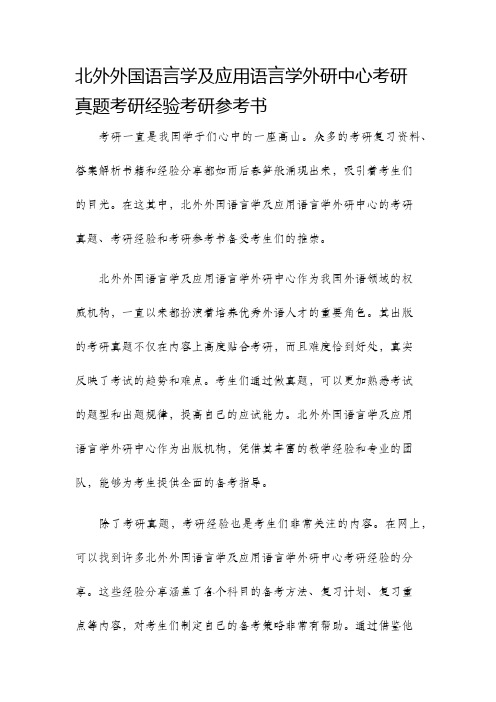
北外外国语言学及应用语言学外研中心考研真题考研经验考研参考书考研一直是我国学子们心中的一座高山。
众多的考研复习资料、答案解析书籍和经验分享都如雨后春笋般涌现出来,吸引着考生们的目光。
在这其中,北外外国语言学及应用语言学外研中心的考研真题、考研经验和考研参考书备受考生们的推崇。
北外外国语言学及应用语言学外研中心作为我国外语领域的权威机构,一直以来都扮演着培养优秀外语人才的重要角色。
其出版的考研真题不仅在内容上高度贴合考研,而且难度恰到好处,真实反映了考试的趋势和难点。
考生们通过做真题,可以更加熟悉考试的题型和出题规律,提高自己的应试能力。
北外外国语言学及应用语言学外研中心作为出版机构,凭借其丰富的教学经验和专业的团队,能够为考生提供全面的备考指导。
除了考研真题,考研经验也是考生们非常关注的内容。
在网上,可以找到许多北外外国语言学及应用语言学外研中心考研经验的分享。
这些经验分享涵盖了各个科目的备考方法、复习计划、复习重点等内容,对考生们制定自己的备考策略非常有帮助。
通过借鉴他人的经验,考生们可以避免一些常见的备考错误,提高备考效率,增加备考成功的可能性。
在备考过程中,考生们还需要参考一些权威的考研参考书。
北外外国语言学及应用语言学外研中心的考研参考书由该中心的教师和专家编写,内容详实、系统,并且与真题密切结合。
这些参考书既有理论知识的概述,又有例题和习题的讲解,帮助考生们更好地掌握考试所需的知识和技能。
考生们可以按照参考书的顺序来进行复习,确保不遗漏任何一个知识点。
当然,在备考过程中只依赖北外外国语言学及应用语言学外研中心的考研真题、考研经验和考研参考书是远远不够的。
考研需要考生们付出很多努力和时间,还需要制定合理的复习计划,找到适合自己的复习方法,多做题、多总结、多练习,才能真正提高自己的水平。
同时,考生们还需要有恒心和毅力,坚持到底,在困难面前不轻易放弃。
综上所述,北外外国语言学及应用语言学外研中心的考研真题、考研经验和考研参考书无疑是考生们备考过程中的宝贵资源。
北京外国语大学英语语言学真题2013年.doc

北京外国语大学英语语言学真题2013年(总分:149.92,做题时间:90分钟)ⅠBriefly explain the following terms. (分数:50.00)(1).affix(分数:5.00)__________________________________________________________________________________________ (2).inflection(分数:5.00)__________________________________________________________________________________________ (3).mood(分数:5.00)__________________________________________________________________________________________ (4).modality(分数:5.00)__________________________________________________________________________________________ (5).interlanguage(分数:5.00)__________________________________________________________________________________________ (6).language transfer(分数:5.00)__________________________________________________________________________________________ (7).speech act(分数:5.00)__________________________________________________________________________________________ (8).verbal behavior(分数:5.00)__________________________________________________________________________________________ (9).co-operative principles(分数:5.00)__________________________________________________________________________________________ (10).vernacular(分数:5.00)__________________________________________________________________________________________ⅡRead the following passage and then answer questions.Alice Kaplan grew up in Minnesota in the 1960s. In her 1993 book, she tells the story of the development of her unconditional, life-long affiliation with French. Her memoirs begin at the age of eight, when her father, a Jewish lawyer who prosecuted Nazi war criminals at Nuremberg, died. Kaplan explains that she felt a deep connection between feeling the loss of her father and feeling different from others in her pursuit of French: "Learning French was connected to my father, because French made me absent the way he was absent , and it made me an expert the way he was an expert" (p.203-4). She began studying French in grade 5, and at the age of 14 attended a French immersion summer programme in Maine. The two formative experiences , however, were a year abroad in a French-medium school in Switzerland at the age of 15, while still in high school, and another academic year abroad in Bordeaux three years later, while she was a French literature undergraduate. Her interest was always as intense for French culture as it was for the French language: "Even in beginning French classes, you know there was a French beyond the everyday , a France of hard talk and intellect" (p.138). By the end of the two full-year study abroad experiences, a complete self-identification with the new community and culture had taken place. She later became a French language teacher and eventually completed a doctorate in French. To this day, Kaplan is committed to a life in which both French and English play prominent roles.(分数:39.97)(1).What does "French made me absent the way he was absent" mean?(分数:5.71)__________________________________________________________________________________________ (2).What is "a French immersion summer programme"?(分数:5.71)__________________________________________________________________________________________(3).What are formative experiences?(分数:5.71)__________________________________________________________________________________________ (4).What is "a French-medium school"?(分数:5.71)__________________________________________________________________________________________ (5).What does Kaplan mean when she says "there was a French beyond the everyday"?(分数:5.71)__________________________________________________________________________________________ (6).What does "the new community and culture" refer to? What is meant by "a completeself-identification" with it?(分数:5.71)__________________________________________________________________________________________ (7).What does Kaplan"s success story illustrate?(分数:5.71)__________________________________________________________________________________________ ⅢRead the following article and then do two tasks.Smoothing the Path from Foreign Lips to American EarsIt is a complaint familiar to millions of alumni of research universities: the master"s or doctoral candidate from overseas, employed as a teaching assistant, whose accent is too thick for undergraduate students to penetrate.To help solve this problem, increasingly sophisticated software programs have been developed to analyze and critique speech . One program, NativeAccent, which became available three years ago, has been adopted by more than 100 universities. Briju Thankachan, an Indian graduate student here in instructional technology , has spent hundreds of hours using NativeAccent. The software can isolate hundreds of pronunciation issues and even show animations of how to position parts of the mouth for each sound."Every morning I would hear him repeating things over and over into the computer, and you could hear him getting better," said Mr. Thankachan"s wife, Betsy J. Briju, a visiting assistant professor in plant biology.The comprehension problem is far from solved. Even at an institution like Ohio University, with an unusually robust remedial program , undergraduate students say they have run intohard-to-understand teaching assistants."You get better at understanding after a while, and they"re willing to talk it over again, but it can be hard," said Karen Martinez, a sophomore from Chicago.The university"s efforts to address the accent problem date to the 1980s. Every foreign student"s command of spoken English is assessed on arrival, and each year about 300 go through the improvement program, part of the linguistics department. In classes, the students learn to break language into individual sounds, forcing them to be aware of how each part of the mouth is positioned to make a particular bit , while instructors contort their faces and touch their tongues to drive home the point . Students take sentences apart to learn rhythm, emphasis, pauses and rising and falling pitch—elements that can convey as much information as words."Many people come here without having learned intonation at all," said Lara Wallace, a lecturer in linguistics. "Everything comes out in a flat monotone, which makes an accent even harder to understand."Students are assigned to practice in computer labs, using the speech analysis software, and —possibly the most unpopular exercise—recording audio or video of themselves speaking. They have to transcribe those recordings verbatim , with every pause, false start , repetition or "um" noted.(分数:59.95)(1).Answer the following questions.What does "critique speech" mean?(分数:5.45)__________________________________________________________________________________________(2).What kind of technology is "instructional technology"?(分数:5.45)__________________________________________________________________________________________ (3).Which two words can be used to replace the two underlined words in " isolate hundreds of pronunciation issues "?(分数:5.45)__________________________________________________________________________________________ (4).What does the word "position" mean in "position parts of the mouth"? Which "parts" are involved?(分数:5.45)__________________________________________________________________________________________ (5).What does the word "things" refer to?(分数:5.45)__________________________________________________________________________________________ (6).What kind of program is a "remedial program" and what is meant by "robust." (ibid.)?(分数:5.45)__________________________________________________________________________________________ (7).What does the word "bit" refer to?(分数:5.45)__________________________________________________________________________________________ (8).What is "intonation"?(分数:5.45)__________________________________________________________________________________________ (9).Which phrase can be used to replace "verbatim" ?(分数:5.45)__________________________________________________________________________________________ (10).What is a "false start"?(分数:5.45)__________________________________________________________________________________________ (11).Write a short essay in approximately 300 words about the issue of pronunciation and intonation for foreign learners of English.(分数:5.45)__________________________________________________________________________________________。
北京第二外国语学院外国语言学及应用语言学考研真题及参考书

Байду номын сангаас
北京第二外国语学院 2012 年攻读硕士学位研究生参考书目 北京第二外国语学院咨询电话:(010)82885878 陈老师:1275181476@ 陆老师:1398338755@
北京第二外国语学院 2012 年攻读翻译硕士专业学位研究生专业目录 单位名称:北京第二外国语学院 单位代码:10031 培养单位:日语学院 邮政编码:100024 地址:北京市朝阳区定福庄南里 1 号 电话:(010)65778437
才思教育考研考博全心全意
02 英语教学研究: Jeremy Harmer. How to Teach English, Addison Wesley Longman Limited. (1998). 外语教学与研究出版社,2000 年。 03 跨文化交际: 《实用文本汉译英》,方梦之,青岛出版社,2003 年。 同时注意阅读近期《中国翻译》、《中国科技翻译》、《上海翻译》等学术期刊论文及翻译习题。
专业学位类别名 专业领域名称 招生人 马克思主义理
外国语
称/代码
/代码
数 论课
业务课考试 业务课考试科目
科目一
二
翻译硕士 0551
日语笔译 05 15
5105 日语口译 05
15 5106
101 思想政 213 翻译硕 359 日语翻译 448 汉语写作与百
治理论
士日语
基础
科知识
备注:翻译硕士专业学位研究生招生注意事项 1. 报考条件、报名手续、考试安排 以上三项均与全国硕士研究生入学考试相关规定、安排相同。 2. 学制 翻译硕士专业学位研究生学习期限为脱产 2 年。 北京第二外国语学院 2012 年攻读工商管理硕士、旅游管理硕士专业学位研究生专业目录 单位名称:北京第二外国语学院 单位代码:10031 培养单位:旅游管理学院 邮政编码:100024 地址:北京市朝阳区定福庄南里 1 号 电话:(010)65778472
- 1、下载文档前请自行甄别文档内容的完整性,平台不提供额外的编辑、内容补充、找答案等附加服务。
- 2、"仅部分预览"的文档,不可在线预览部分如存在完整性等问题,可反馈申请退款(可完整预览的文档不适用该条件!)。
- 3、如文档侵犯您的权益,请联系客服反馈,我们会尽快为您处理(人工客服工作时间:9:00-18:30)。
2002年语言学与应用语言学(100 points)All the questions are to be answered in English on the answer sheets provided.1. Displacement,arbitrariness,productivity,cultural transmission,discreteness and duality are sometimes listed as the 6 core features of human language.Choose 3 out of the 6 and explain with examples what they mean. (12 points)2. Briefly explain what phonetics and phonology are concerned with and what kind of relationsips hold between the two.(10 points)3.In deriving new words via a prefix such as mis-, there seems to be some constraint on what is permitted. The words in the first colum below are acceptable formations,but in the other columns are not.Work out what the rule(s) might be for making new adjectives with the prefix mis-. (18 points)Column I : misadventure misjudgement misplaced mistrustfulColumn II: *mishappy *mismeal *misglad *misroleColumn III: *mismilk *missad *misword *miscrazy4. Using what you know about Grice's cooperative principle and its four maxims,analyze the following short exchange.(20 points)同事甲:小张昨晚去哪儿了?同事乙:今天在早上我看见一辆白色富康停在小林家门口。
5. In each of the following sentences,the second part cancels some information given by the first part. However,this seems to result in quite acceptable utterances in group (1) and in very awkward utterances in guoup (2). Explain why. (20 points)Group (1)a.老张有三个孩子,其实还不止三个。
b.我只喜欢黄色和蓝色,不过试试红色也未尝不可。
c.约翰的普通话说得还可以,确切地说是非常棒。
Group (2)*d.我特后悔选修了这门课,其实我没有选修这门课。
*e.她这次考试又不及格,不过她上次及格了。
*f.我在乡下日子过得很苦,说真的我没在向下呆过。
6. Put yourself into the position of an English teacher in China. What are your goals and the goals of the students and the educational sysem in the teaching and learning of English? When the goeals do not converge,how can you reconcile the differences between them?(20 points)2003 年语言学与应用语言学All the questions are to be answered in English on the answer sheets provided.1.Words in our mental lexicon are known to be related to one another. Discuss the relationships between words,using examples from the English language.(15 points)2.Some grammar books say there are three basic tenses in English-the present,the past and the future; others say there are only two basic tenses,-the present and the past. Explain what tense is and whether it is justifiable to say there is a future tense in English.(35 points)3.(1) Give an account of what you know about the English subjuntive mood.(20 points)(2) If you are to teach a group of senior middle school students the subjunctive mood in 45 minutes,how are you going to plain your class?(20 points)4. It has been observed that women tend to approximate more closely to the standard language than men do.Why do you think is this so?(30 points)5.What do you think are teh similarities and dissimilarities between learning a first and a second language?(30 points)2004年语言学与应用语言学IMPORTANTAll the questions are to be answered in English on the answer sheets provided.1. Shakespeare has Juliet say:What is in a name?That which we call a roseBy any other name would smell as sweet.What do you think the above lines say to you about the relationship between the form (sounds) andmeaning (concept) of a word in spoken language?Explain with positive evidence as well as exceptions from the English language. (15 points)2.How much does our language influence the way we think? How deeply do language and culture interpenetrate and influence one another?These questions about language have fascinated thinkers throughout the ages.For example,Johann Gottfried Herder and Wilhelm von Humboldt in the German Romantic tradition regarded language as a prisma or grid spread over things in the world so that each language reflects a different worldview. Write a short essay to explain your position on this view. (35 points)3.Is English a language that uses a phonetic alphabet system? Explain briefly why or why not with examples.(15 points)4.Suppose you were given four cards,each of which had a different phoneme of English printed on it:/k/, /b/, /l/, /i/Now arrange these cards to form all "possible" words that these four phonemes could form. Discuss what rules you have followed to come up with these words. (20 points)5.Paraphrase each of the following sentences in two different ways to show that you understand the ambiguity involved: (10 points)a. Dick finally decided on the boat.b. The professor's appointment was shocking.c. The governor is a dirty street fighter.d. Terry loves his wife and so do I.e. No smoking section available.6.It is argued that grammatically judgments do not depend on whether the sentence is meaningful or not,as shown by the sentence "Colorless green ideas sleep furiously",which doesn't make much sense but is syntactically well formed. How would you respond to this argument? (25 points)7.TOEFL often requires the examinees to specify the situational context after listening to a conversation.See for example a tape-script below for an exam item:V oice A (male): How much is this tie?V oice B (female): Forty.V oice C (male): Where does this conversation most probably take place?What do you think is the TOEFL people's belief about what constitutes linguistic competence and howlinguistic competence can be tested? (30 points)2005年语言学与应用语言学All the questions are to be answered in English on the answer sheets provided.1.Examine the following two statements about language,and discuss the similarities and differences between them.Do you agree with the two statements?Explain your answer.(25 points)1) Sapir (1921: "Language"): "Language is a purely human and non-instinctive method of communicating ideas,emotions and desires by means of voluntarily produced symbols" (p.8)2) Bloch and Trager (1942: "Outline of Linguistic Analysis"): "A language is a system of arbitrary vocal symbols by means of which a social group co-operates" (p.5)2. What are phonemes,phones and allophones?Explain their relationship with examples from English or Chinese.(15 points)3. Is it possible to seperate semantics and pragmatics?Why or why not? What are the implications of your answer for second language teaching? (30 points)4.It has been noticed that Chinese learners of English tend to make mistakes in the marking of past tense,even at the advanced level of proficiency. What do you think are the possible causes of this problem?How can language teachers help solve this problem and why? (30 points)5. Look at the following real newspaper headlines and explain why they are considered ambiguous. Then revise the headlines so that they can express the intended meanings unambiguously. (20 points)(1) Complaints about NBA Referees Growing Ugly(2) Milk Drinkers Are Turning to Powder(3) Two Sisters Reunited After 18 Years at Checkout Counter(4) Enraged Cow Injures Farmer with Ax(5) Safety Experts Say School Bus Passengers Should Be Belted6. In interpreting utterances such as (1) and (2), the hearer generally treats the events described in the two sentences in each group as causally related even though such relationship is not encoded in the meanings of the sentences. That is,the hearer tends to think htat Helen fell on the ground BECAUSE OF Tom's pushing and that the vase broke BECAUSE it was dropped.Explain why. (30 points)(1) Tom pushed Helen. Helen fell on the ground.(2) Peter dropped the vase. It broke.2006年语言学与应用语言学All the questions are to be answered in English on the answer sheets provided.1,why do you think that, all other things being equal, women use more standard variants of stable sociolinguistic variables than men? (20 points)2,look at the sentence: ‘colorless green ideas sleep furiously’. Explain why the sentence is semantically odd even though it is syntactically well formed. (25 points)3,what, in your view, makes a text, rather than a series of unconnected utterances? What are the implications of your answer for second language teaching? (30 points)4,It has been noted that first language (L1) acquisition is completely successful, but second language (L2) learning is usually not. As Towell & Hawkins(1994:p.14) observe, ‘v ery few learners appear to be fully successful in the way that native speakers are’. How do you account for this difference in ultimate attainment between L1 and L2 acquisition. (25 points)5,analyse the following speech errors, by commenting on how they might have arisen:(20 points)a, he rode his bike to school tomorrow. (ß yesterday )b, gone mild (ß wild/ mad)c, he misfumbled the ball.(ß mishandled/ fumbled)d, that’s torrible. (ß terrible /horrible)6,research has found that two-year-old English children produce negative sentences such as a) to d), but not e):a) he doesn’t like cabbage.b) Doesn’t like cabbage.c) Him no like cabbage.d) No like cabbage.e) * him doesn’t like cabbage.How can you account for this? (30 points)语言学和应用语言学07试卷All the questions are to be answered in English on the answer sheets provided1. Imagine you were at a bus stop and two people approached you one after the other. The first said “哎,几点了?”and the other said “不好意思,打扰一下,请问您戴表了么?”What assumptions would you make if you were addressed in these two ways and why would you make them?2. Explain this statement and give at least two examples of it“In studying other cultures, we do so from the perspective of our own culture.”3. 1)Give an account of what you know about the English present perfect tense.2) If you are to teach a group of junior middle school students the present perfect tense in 45 minutes, how are you going to plan your class?4.A teacher drilled his /her students in the structure called indirect questions:Do you know where my book is?Do you know what time it is?Did he tell you what time it is?As a direct result of the drills, all the students were able to produce the structure correctly in class. After class, a s tudent came up to the teacher and asked, “Do you know where is Mrs. Smith?”, which shows that only minutes after the class the student used the structure incorrectly in spontaneous speech. What do you think is the reason for this misuse? Ws the lesson a waste of time? Why or why not?4. 1) What do you think are the differences between a good language learner and a poor language learner?2) If we know what strategies good language learners use, does it follow that teaching so-called poor language learners to use those strategies will result in their successful language learning? Why or why not?。
